Muscle Identification
1/82
There's no tags or description
Looks like no tags are added yet.
Name | Mastery | Learn | Test | Matching | Spaced |
|---|
No study sessions yet.
83 Terms
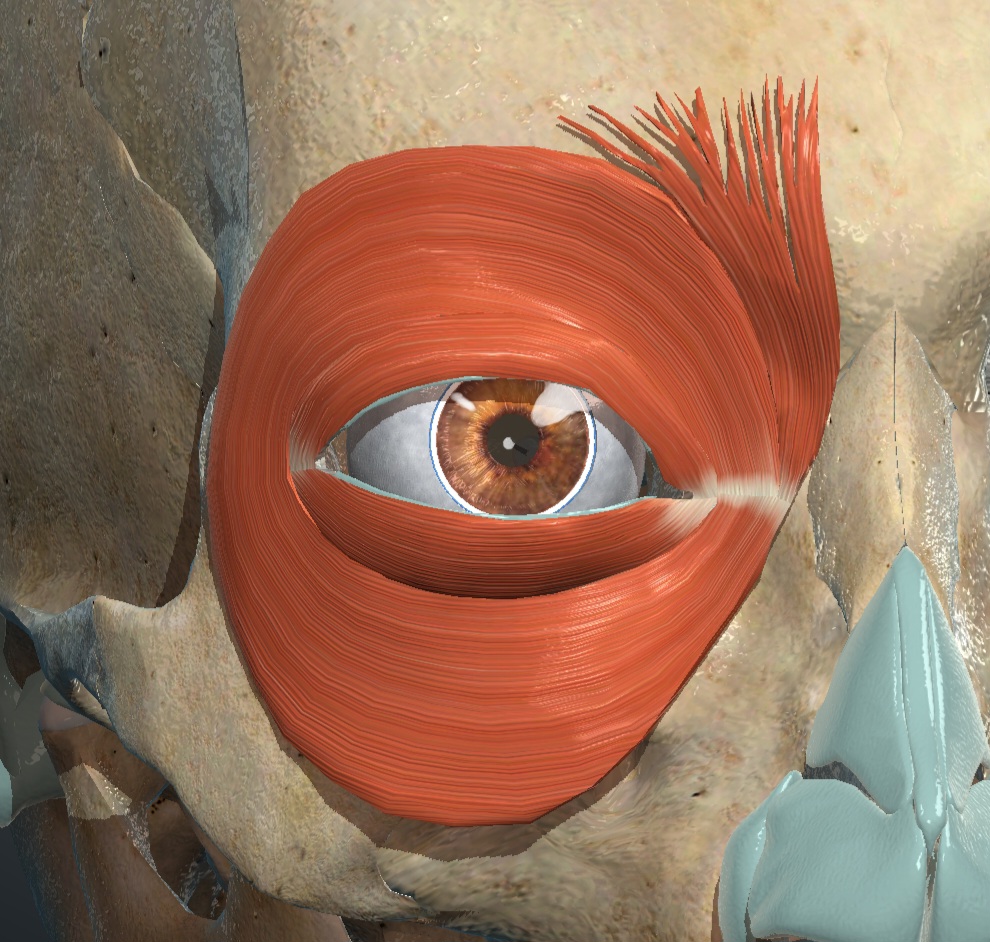
What muscle is this?
Orbicularis Oculi
Origin: frontal process of the maxilla, lacrimal bone, nasal portion of the frontal bone, medial palpebral ligament and lacrimal sac
Insertion: lateral palpebral ligament
Innervation: facial nerve (VII)
Action: closes the eyelids and moves the eyebrows
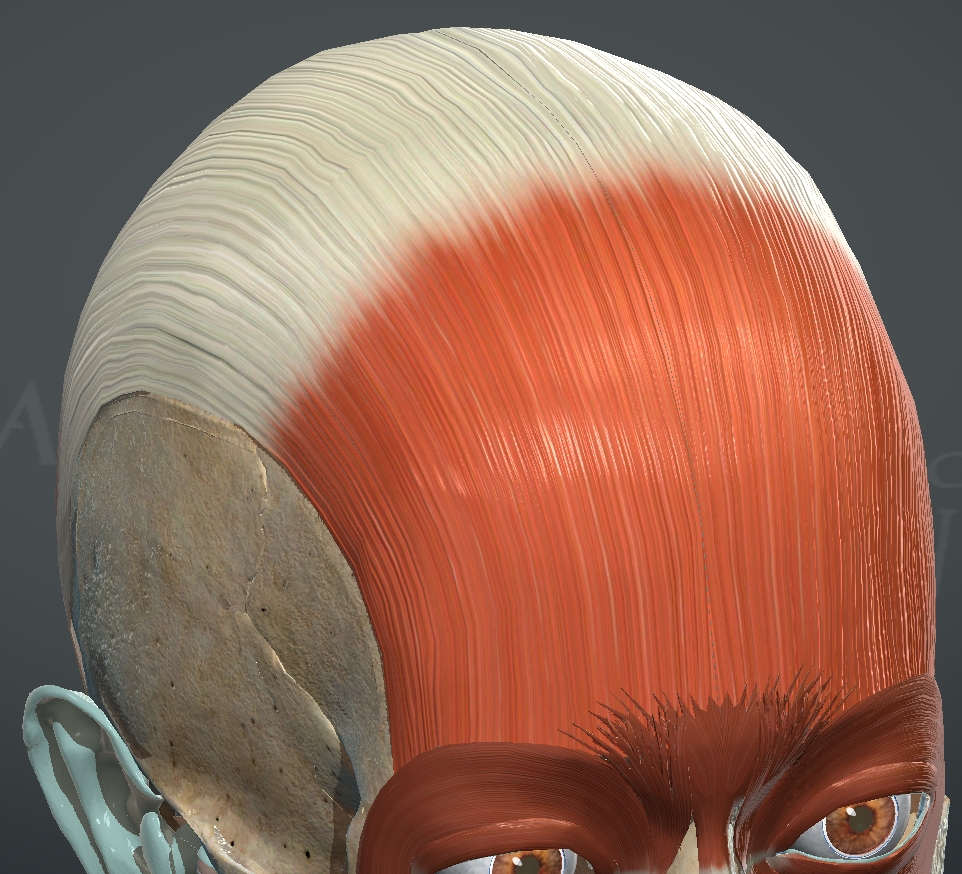
What muscle is this?
Occipitofrontalis Muscle
Origin:
Frontal Belly: skin of the forehead and muscles of the forehead, procerus, superciliary, and orbicularis oculi
Occipital Belly: supreme nuchal line
Insertion: Galea aponeurotica
Innervation: Facial nerve (VII)
Action: Scalp movement
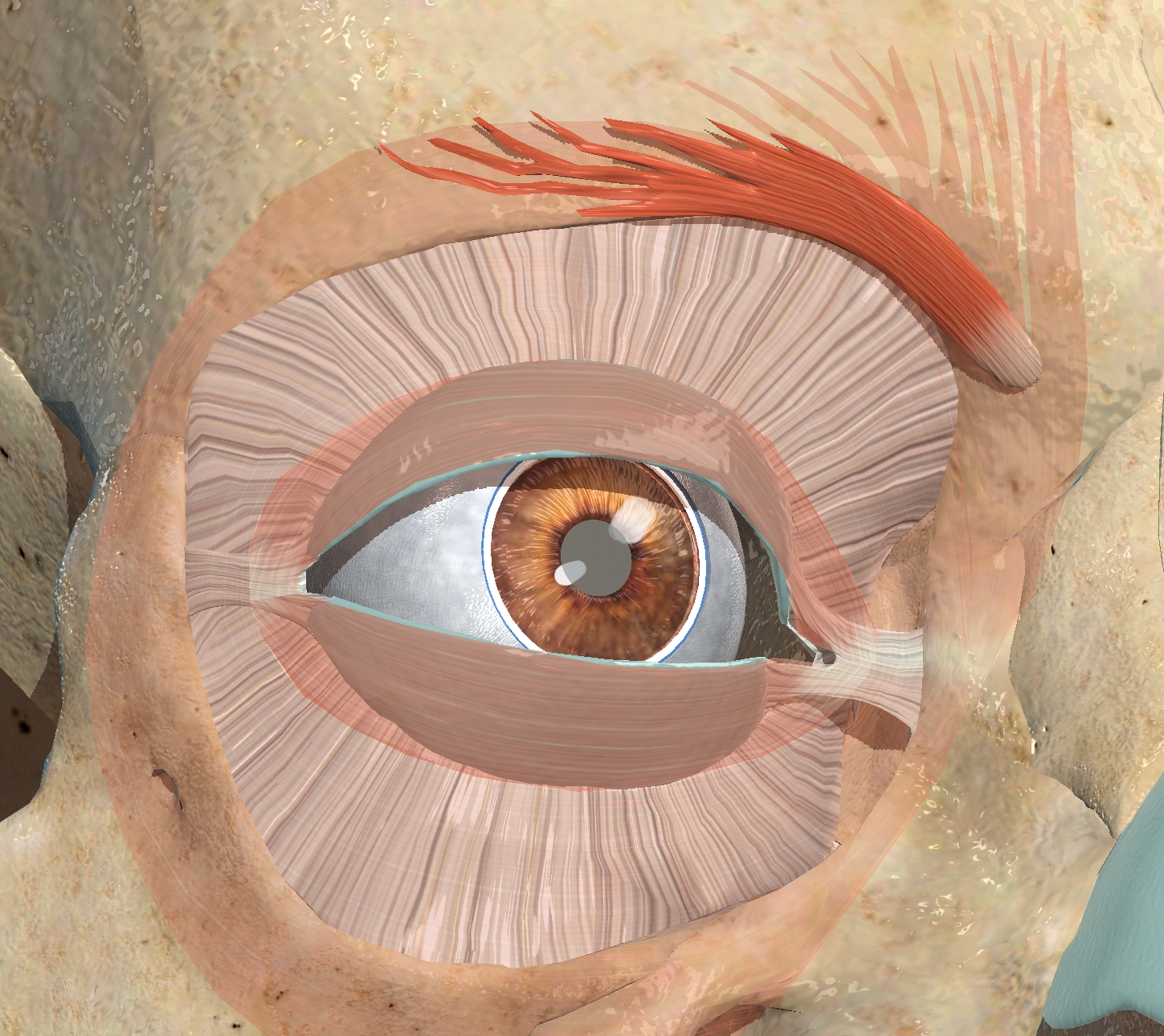
What muscle is this?
Corrugator Supercilli Muscle
Origin: medial end of superciliary arches, and fibers of the orbicularis oculi muscle
Insertion: skin above the middle of the supraorbital margin
Innervation: Temporal branches of facial nerve (CN VII)
Action: Creates vertical wrinkles over glabella
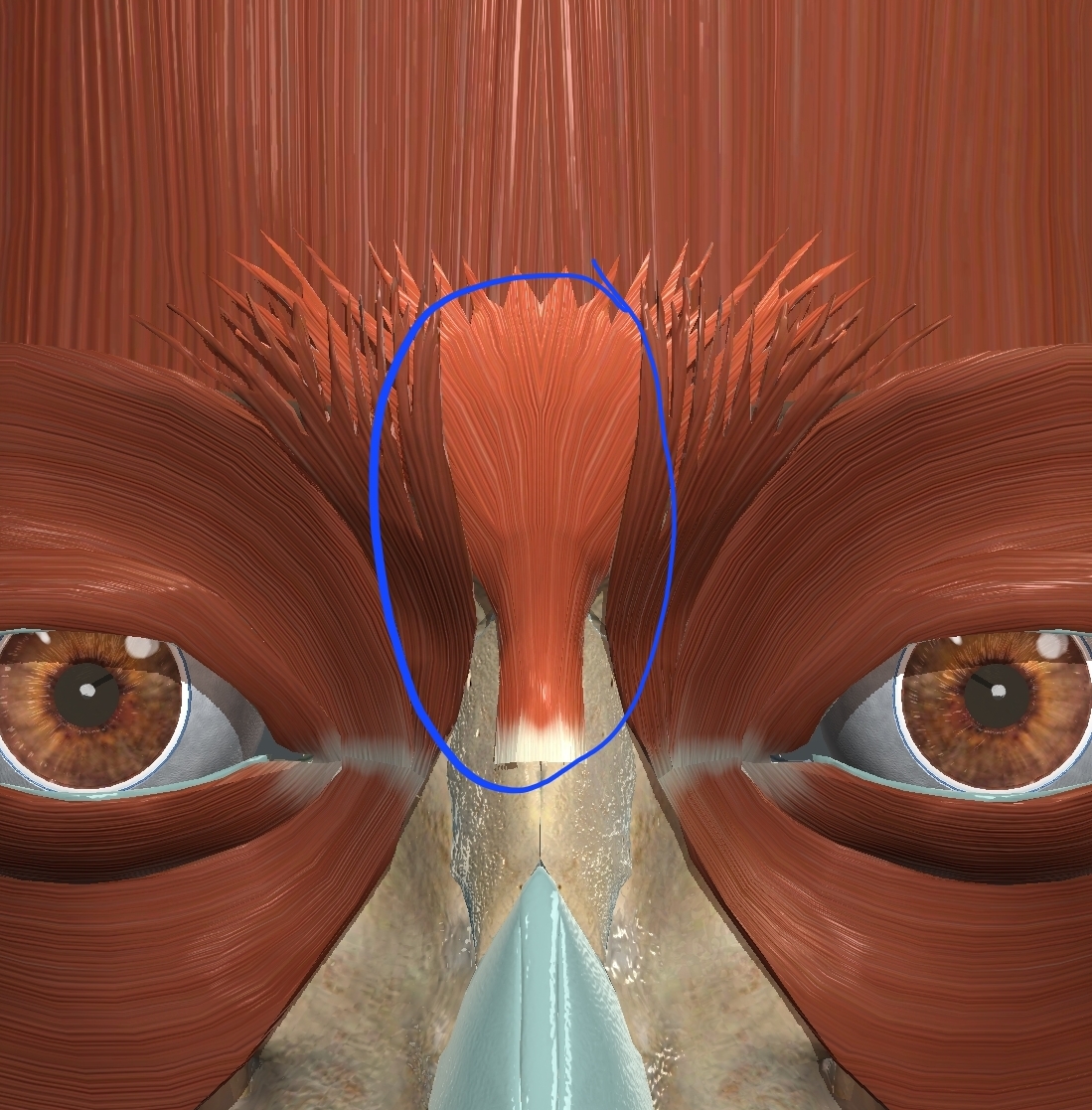
What muscle is this?
Procerus Muscle
Origin: Nasal bone and lateral nasal cartilage
Insertion: Skin of the glabella
Innervation: Facial nerve (VII)
Action: Depresses the eyebrows and forehead
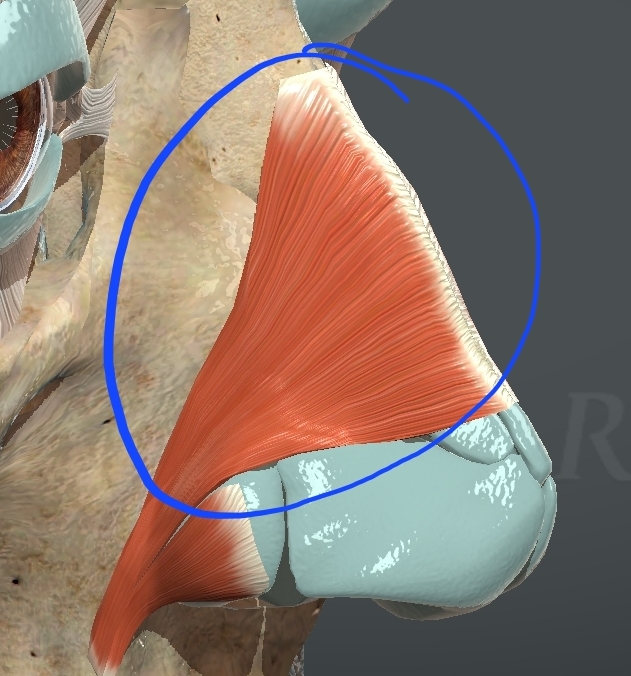
What muscle is this?
Transverse Part of Nasalis
Origin: Alveolar eminence of the canine
Insertion: lateral nasal cartilage and aponeurosis of the bridge of the nose
Innervation: Facial nerve (VII)
Action: Depression of the nasal septum
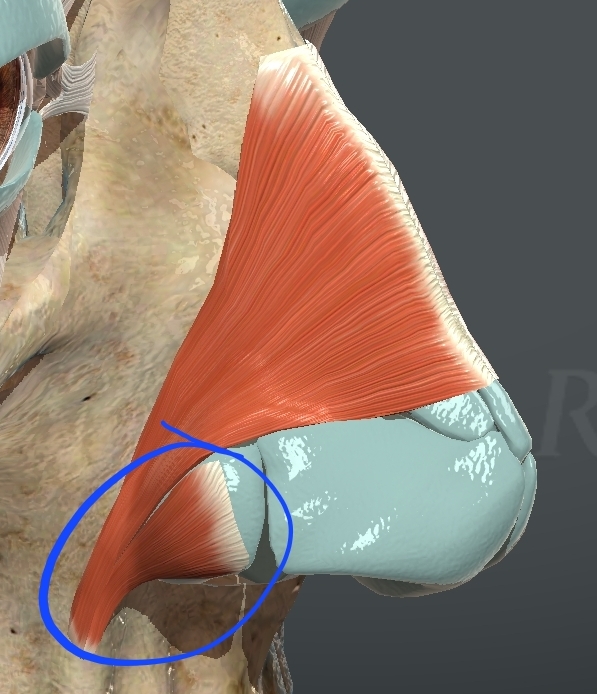
What muscle is this?
Alar Part of Nasalis
Origin: Alveolar eminence of the lateral incisor
Insertion: Wings of the nose and edges of the nostril
Innervation: Facial nerve (VII)
Action: Wing cartilage abductor, expansion of the nostrils
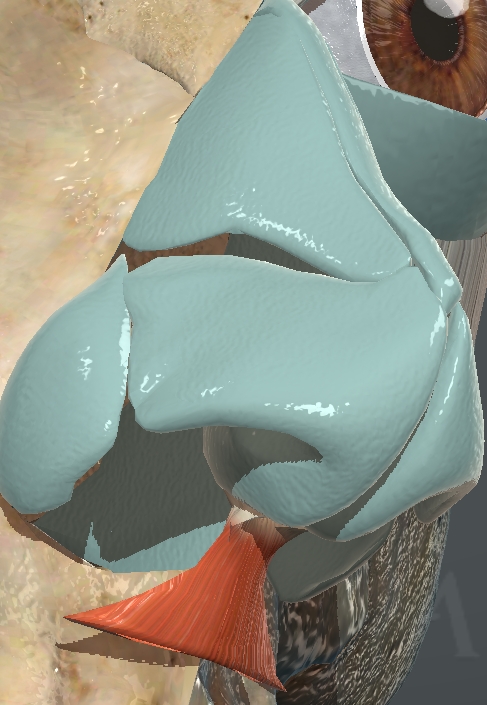
What muscle is this?
Depressor Septi Nasi Muscle
Origin: Alveolar eminence of the medial incisor
Insertion: Greater alar cartilage and septal cartilage
Innervation: Facial nerve (VII)
Action: Nasal septum depression
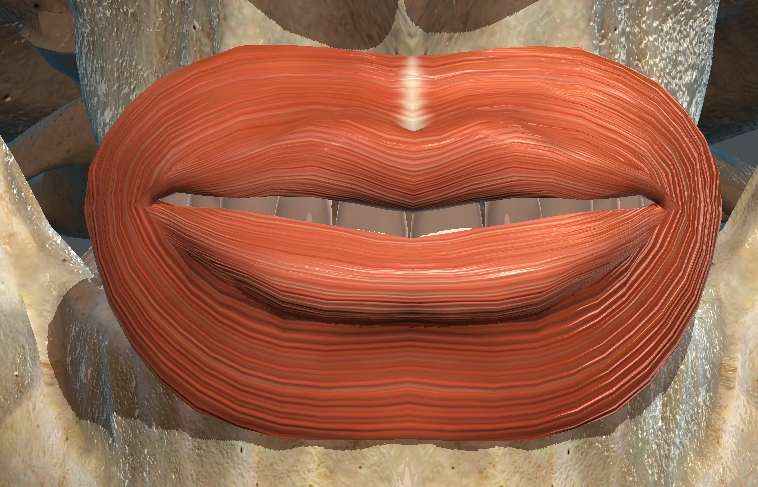
What muscle is this?
Orbicularis Oris
Origin: Lateral to the angle of the mouth
Insertion: Mucous membrane of the lips
Innervation: Facial nerve (VII)
Action: Closes and protrudes the lips
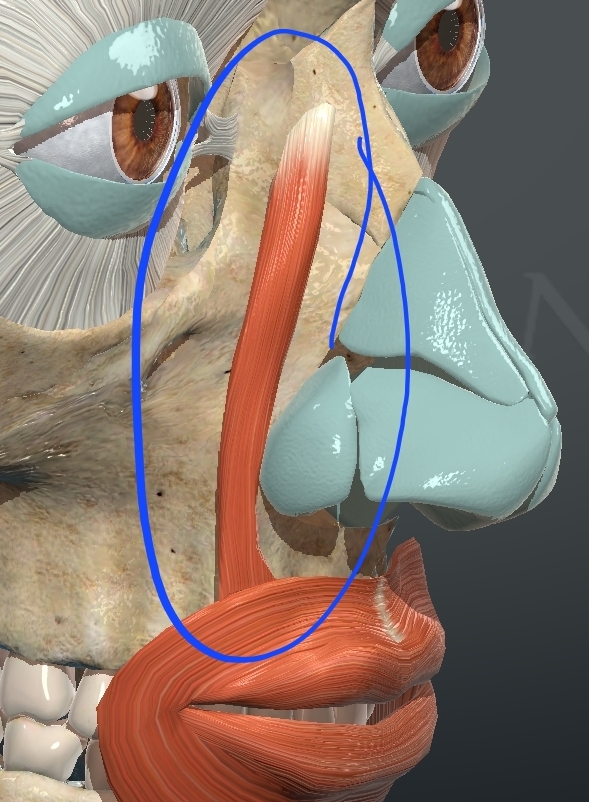
What is this muscle?
Levator Labii Superioris Alaeque Nasi
Origin: Frontal process of the maxilla
Insertion: Wings of the nose and upper lip
Innervation: Facial nerve (VII)
Action: Elevator of the upper lip and wings of the nose
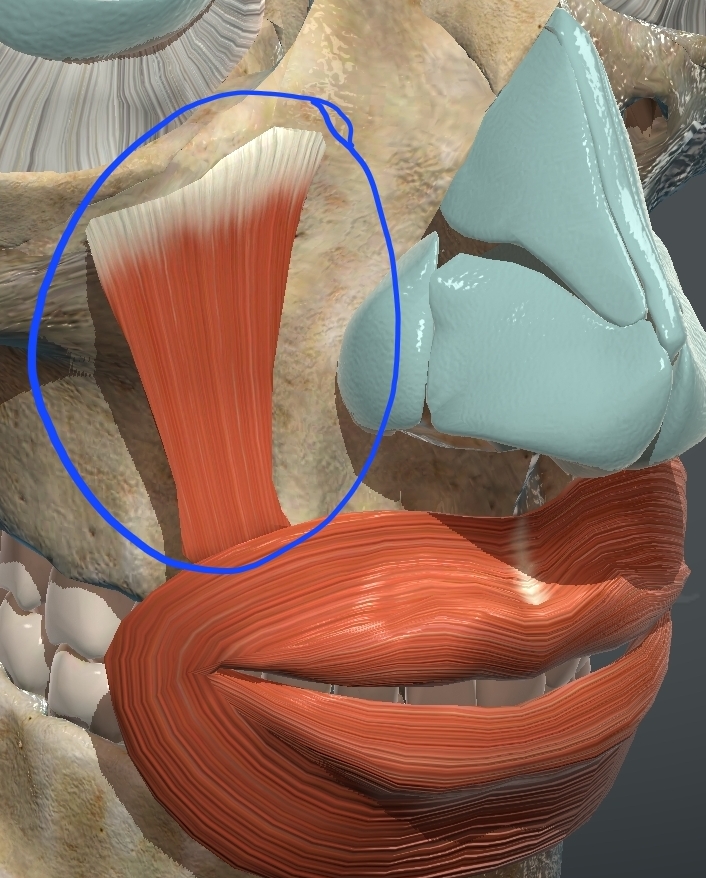
What is this muscle?
Levator Labii Superioris
Origin: Infraorbital edge and zygomatic process of the maxilla
Insertion: Upper lip
Innervation: Facial nerve (VII)
Action: Elevator of the upper lip
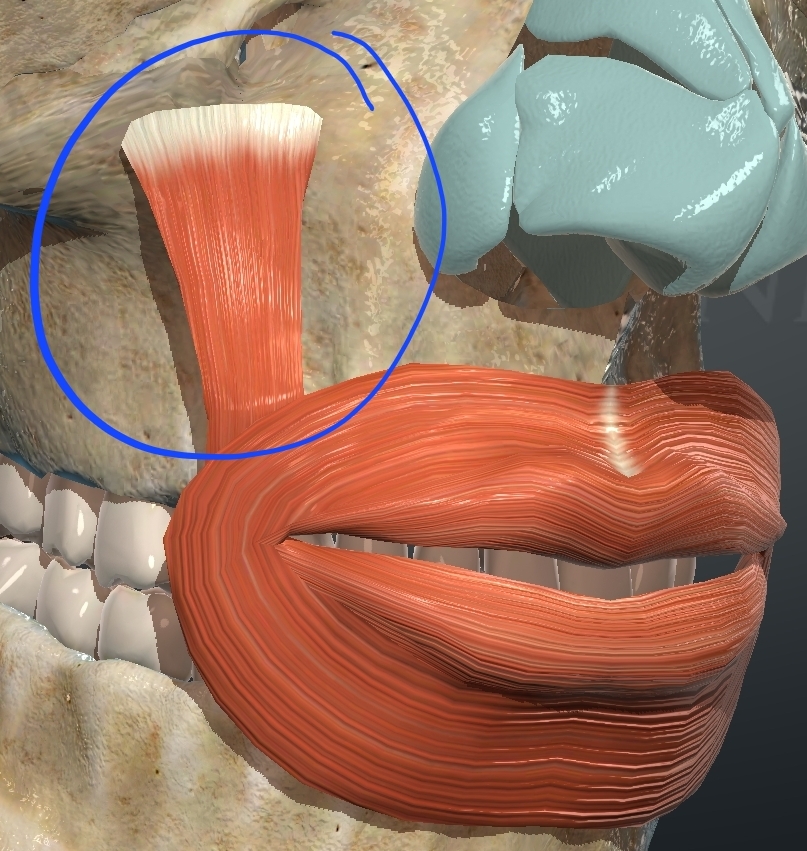
What is this muscle?
Levator Anguli Oris
Origin: Canine fossa of the maxilla
Insertion: Angle of the mouth
Innervation: Facial nerve (VII)
Action: Elevator of the labial commissure
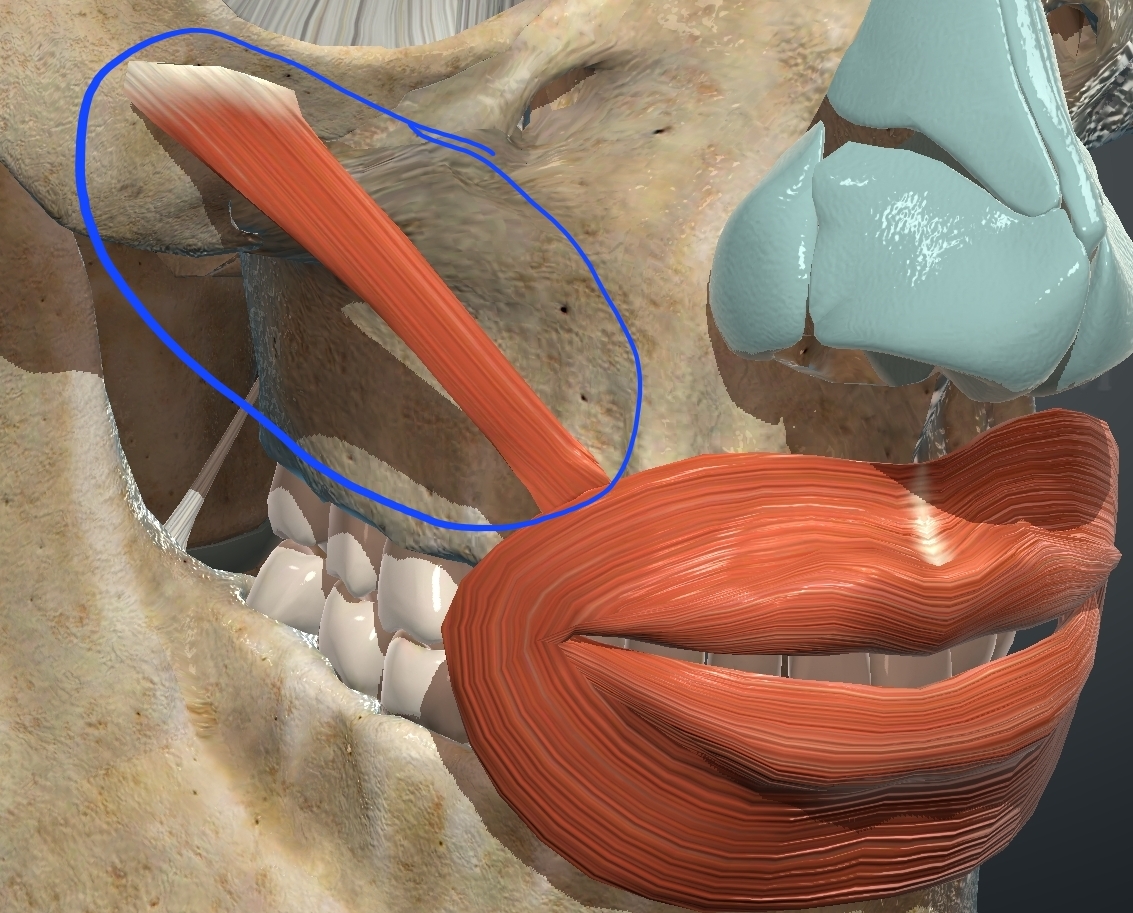
What is this muscle?
Zygomaticus Minor
Origin: Zygomatic bone, near the zygomaticomaxillary suture
Insertion: Upper lip and angle of the mouth
Innervation: Facial nerve (VII)
Action: Levator and abductor of the middle part of the upper lip
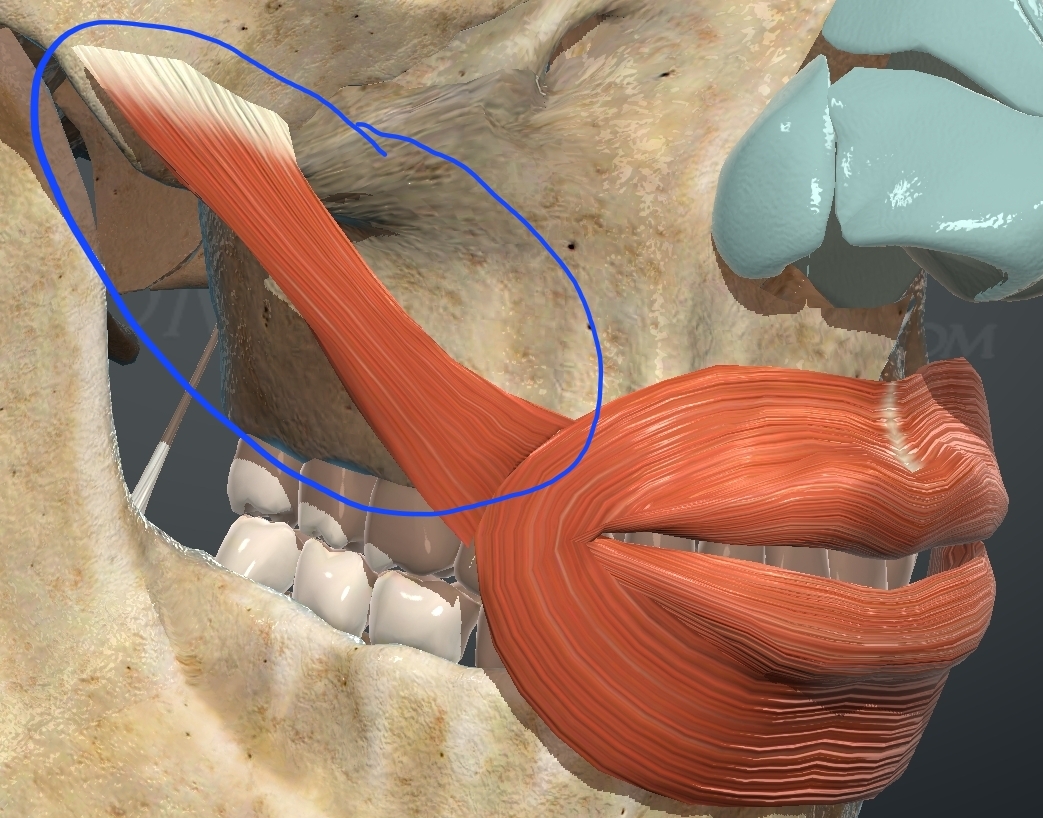
What is this muscle?
Zygomaticus Major
Origin: Zygomatic bone, near the zygomaticotemporal suture
Insertion: Upper lip and angle of the mouth
Innervation: Facial nerve (VII)
Action: Elevator and abductor of the labial commissure
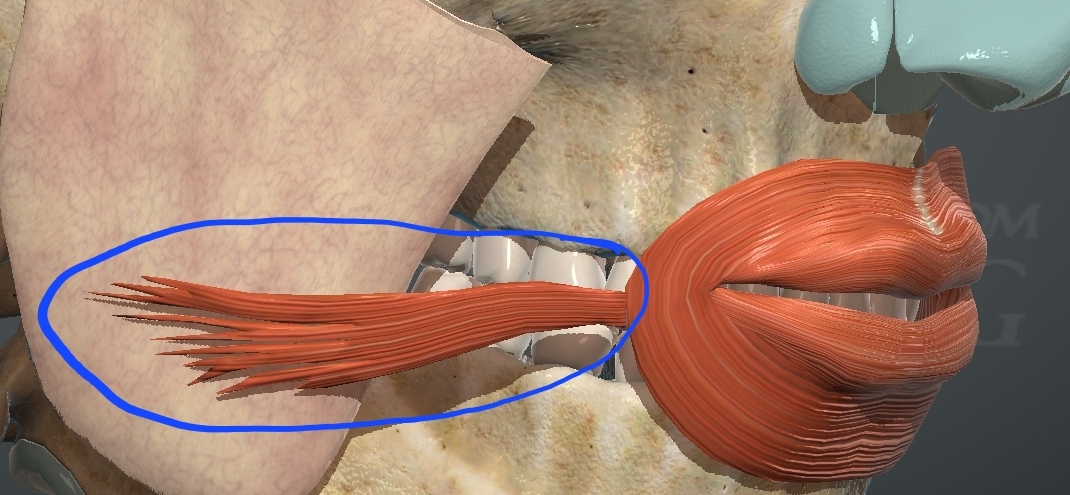
What is this muscle?
Risorius Muscle
Origin: Parotidomasseteric fascia
Insertion: Angle of the mouth
Innervation: Facial nerve (VII)
Action: Abductor of the labial commissure
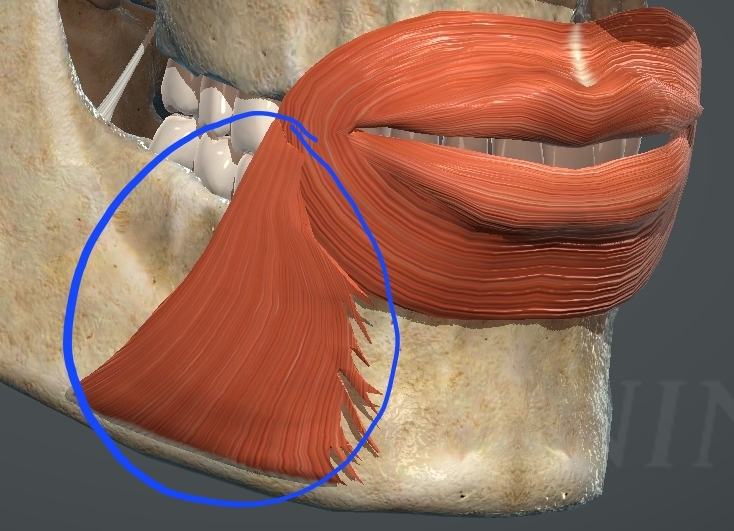
What is this muscle?
Depressor Anguli Oris
Origin: Base of the mandible, inferior to the mental foramen
Insertion: Lips and labial commissure
Innervation: Facial nerve (VII)
Action: Depressor of the labial commissure
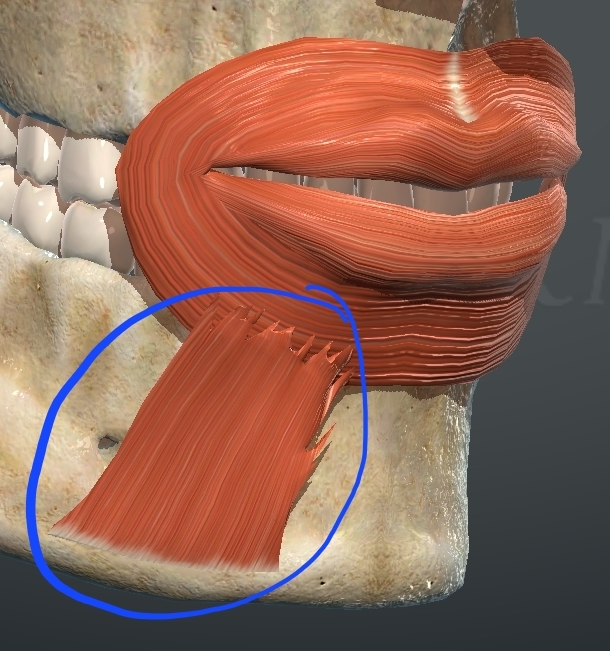
What is this muscle?
Depressor Labii Inferioris
Origin: Mandibular base and inferomedial region to the mental foramen
Insertion: Lower lip
Innervation: Facial nerve (VII)
Action: Depressor of the lower lip
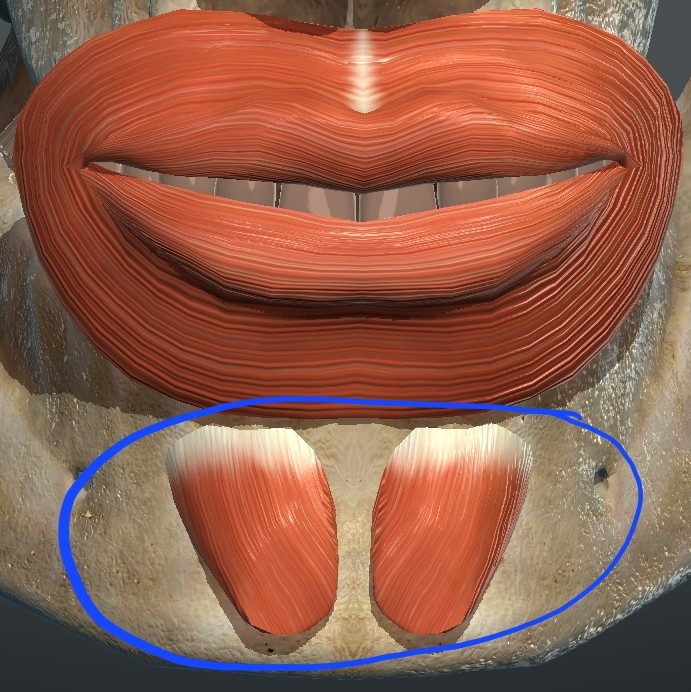
What is this muscle?
Mentalis
Origin: Alveolar eminence of the lower lateral incisor
Insertion: Skin of the chin
Innervation: Facial nerve (VII)
Action: Elevation of the chin and protrusion of the lower lip
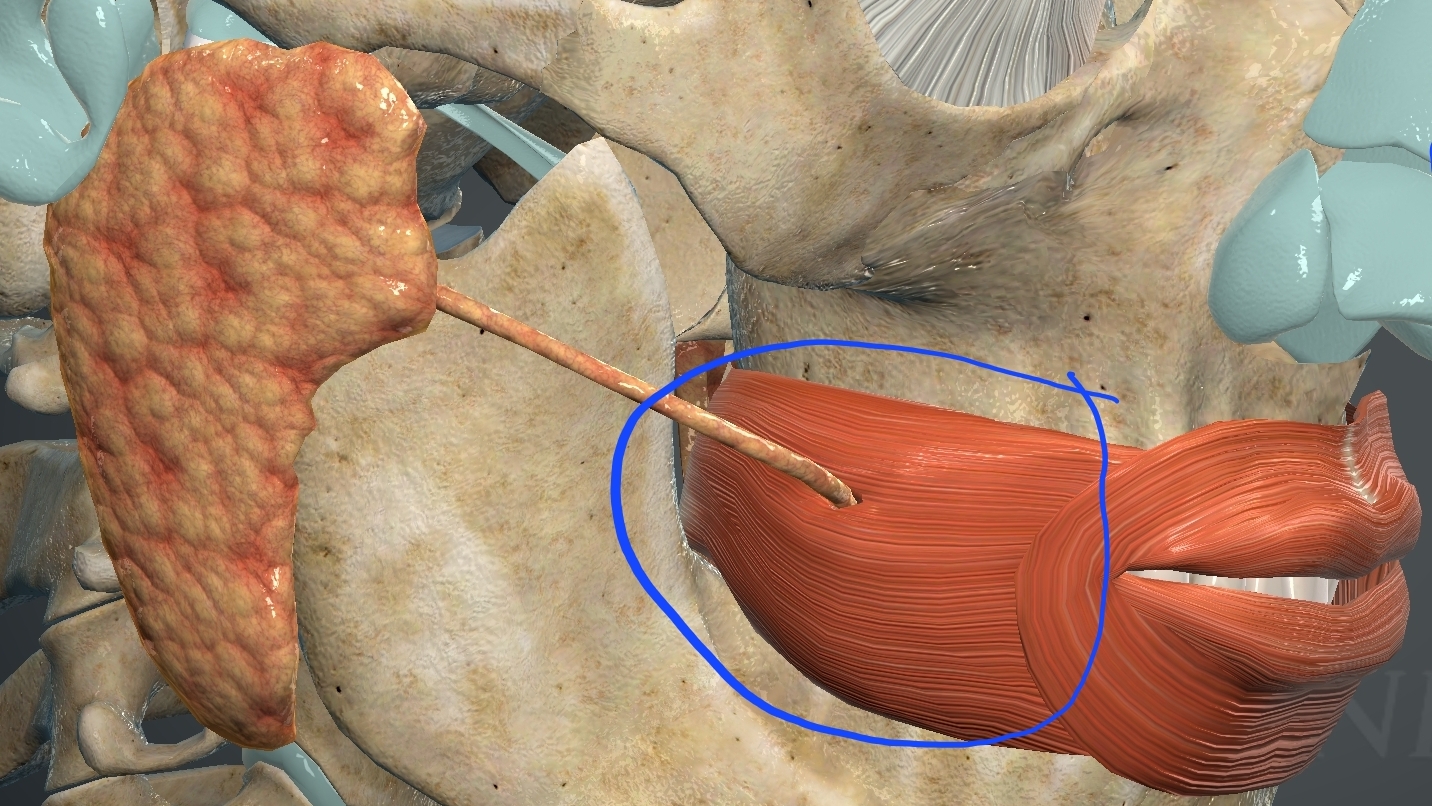
What is this muscle?
Buccinator
Origin: Mandible, pterygomandibular raphe, and alveolar processes of the maxilla and mandible
Insertion: Angle of the mouth
Innervation: Facial nerve (VII)
Action: Presses cheek against the molar teeth (aids in chewing), expels air between lips
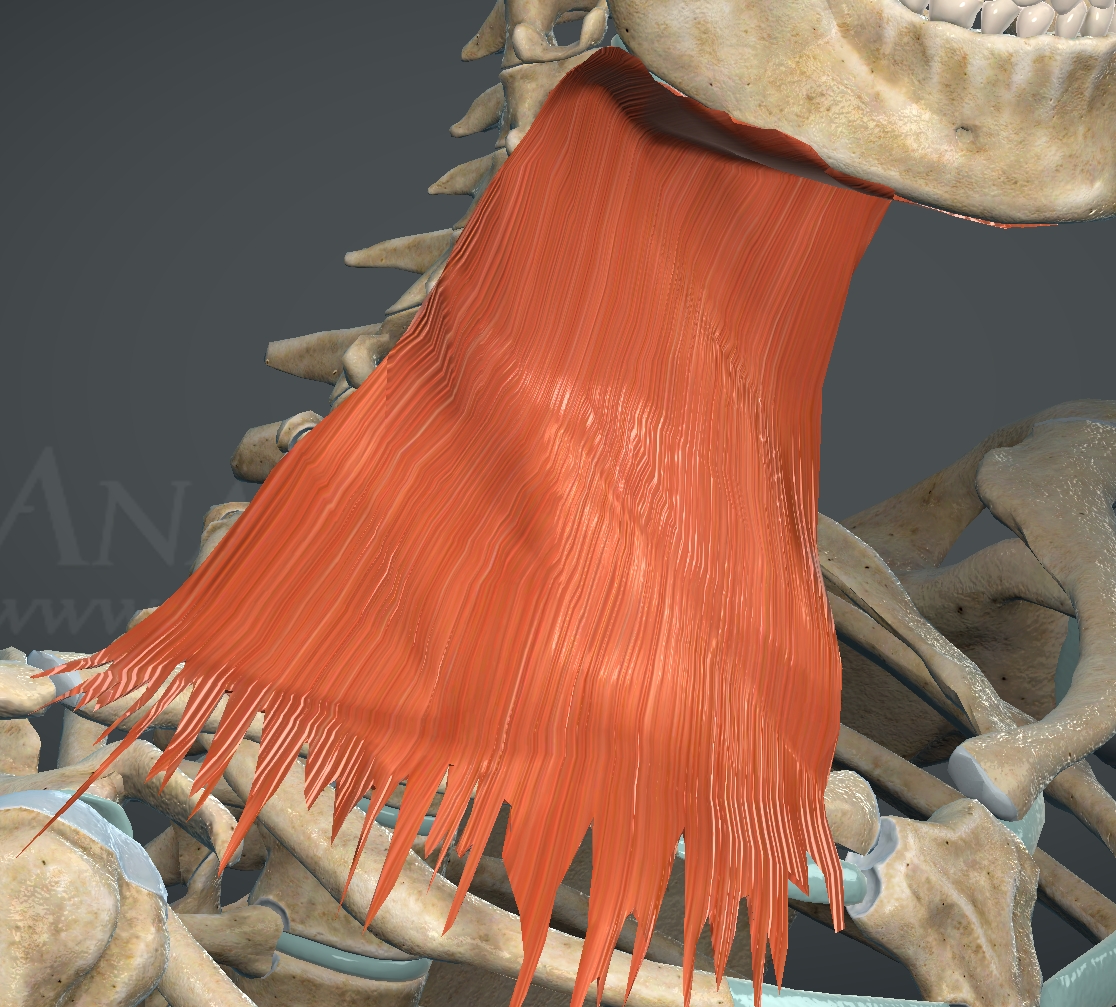
What is this muscle?
Platysma
Origin: Subcutaneous cellular tissue of the subclavicular and acromial regions
Insertion: Inferior border of the mandible, skin of the mentonian region, and mandibular oblique line
Innervation: Facial nerve (VII)
Action: Lowering of the mandible and labial commissures (in expressions of tension or stress), tightens the skin of the cervical region releasing pressure from the superficial veins
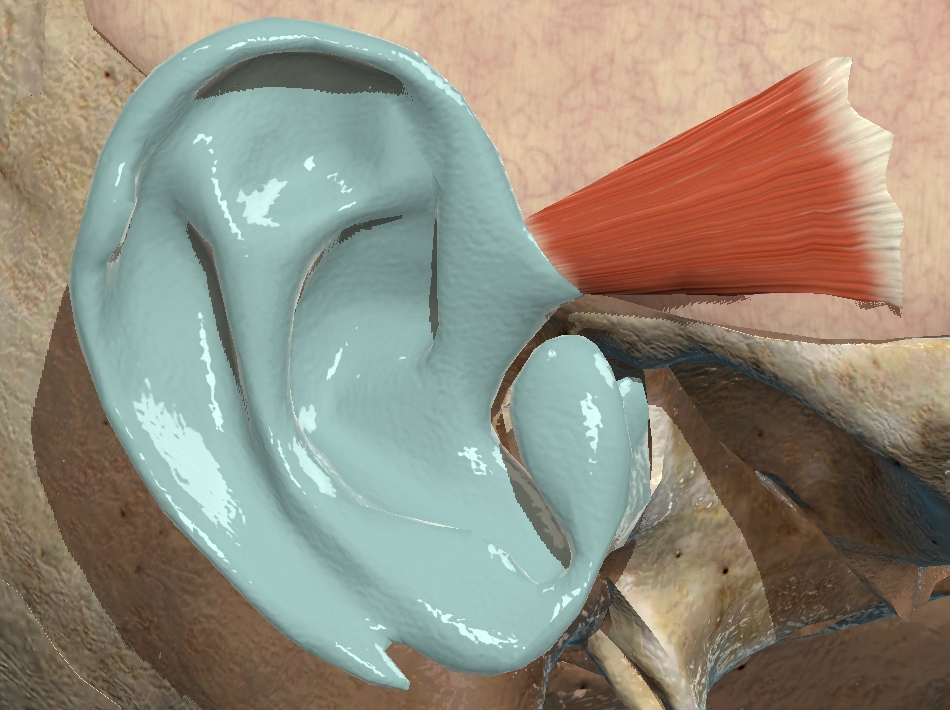
What muscle is this?
Auricularis Anterior
Origin: Temporal fascia
Insertion: Helix major (anterior)
Innervation: Temporal branch of the facial nerve (VII)
Action: Pulls the ear anteriorly
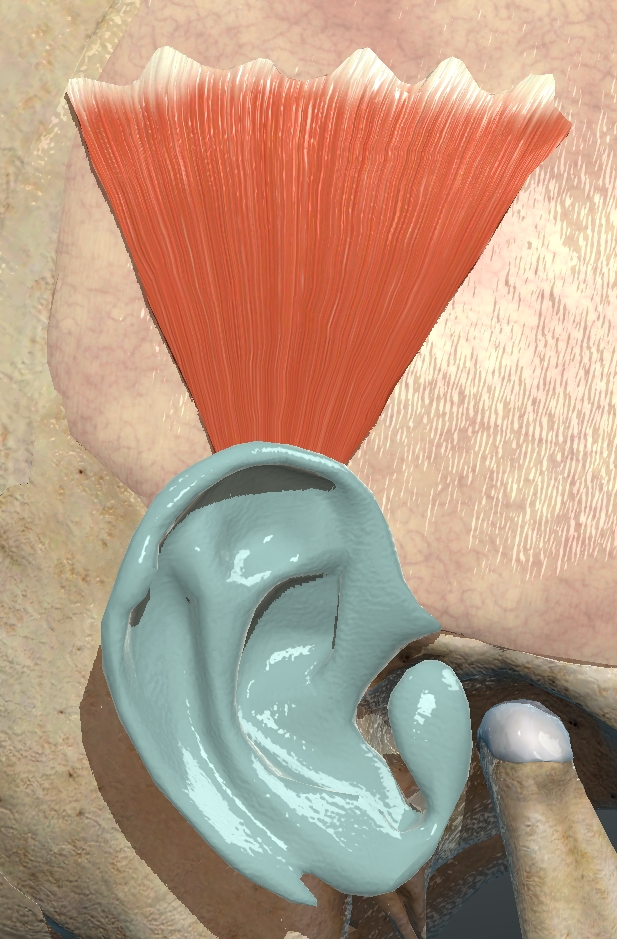
What muscle is this?
Auricularis Superior
Origin: Temporal fascia
Insertion: Helix major (superior)
Innervation: Posterior auricular nerve of the facial nerve (VII)
Action: Pulls the ear superiorly
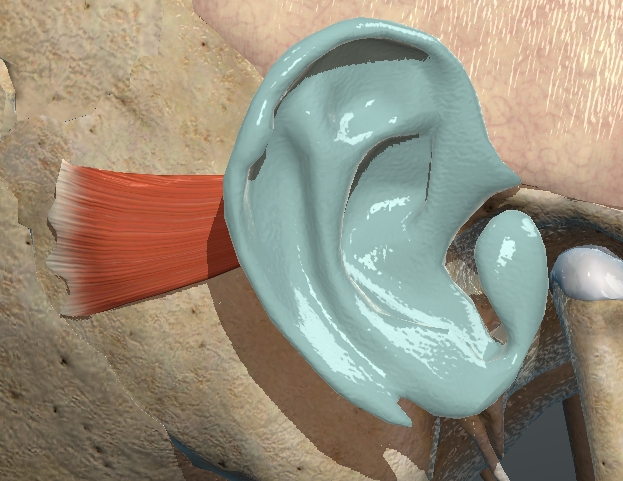
What muscle is this?
Auricularis Posterior
Origin: Mastoid process
Insertion: Helix major (posterior)
Innervation: Posterior auricular nerve of the facial nerve (VII)
Action: Pulls the ear posteriorly
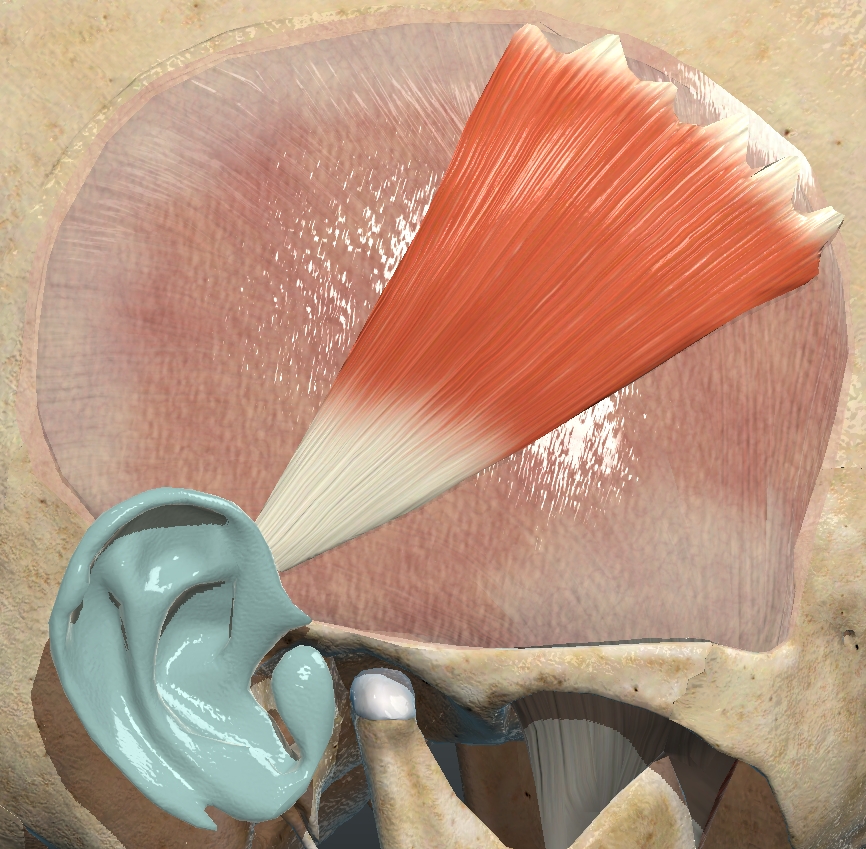
What muscle is this?
Temporoparietalis
Origin: Helix and auricular muscles
Insertion: Galea aponeurotica
Innervation: Facial nerve (VII)
Action: Helps with facial gestures
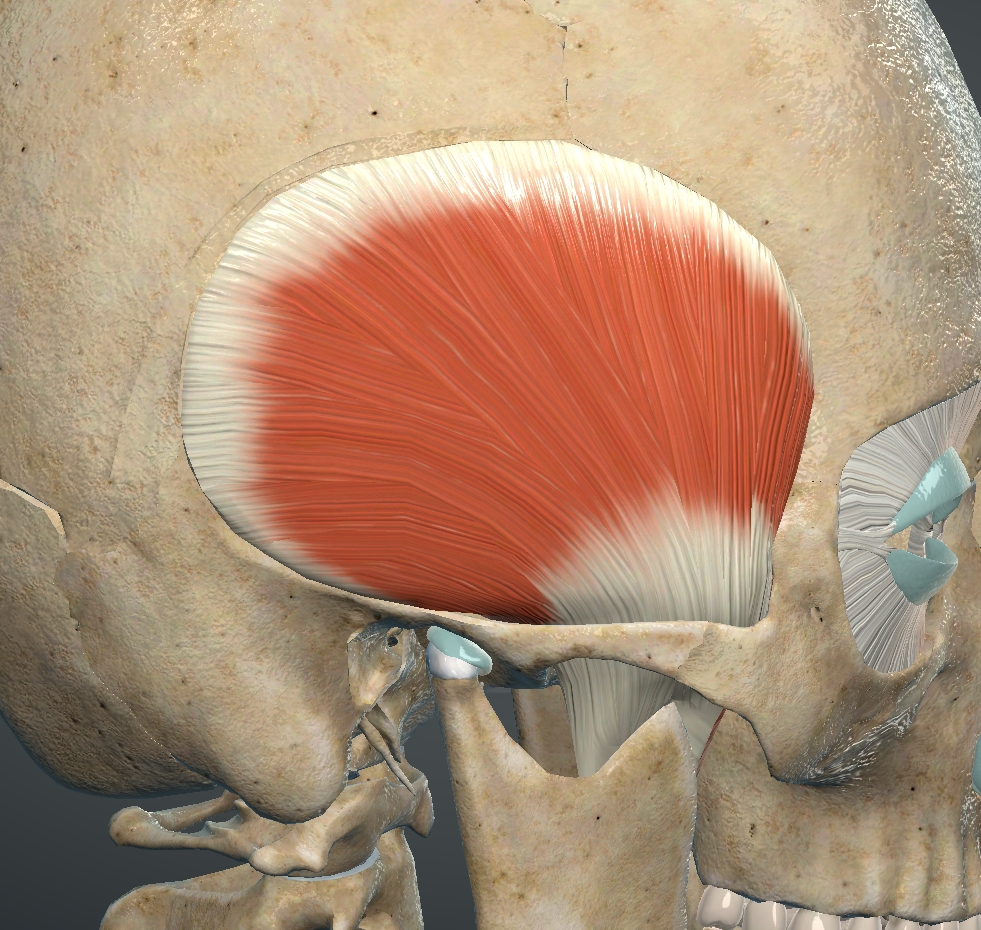
What muscle is this?
Temporalis
Origin: Temporal fossa
Insertion: Coronoid process of the mandible
Innervation: Deep temporal nerves (branches of mandibular nerve V3)
Action: Elevation and retraction of the mandible
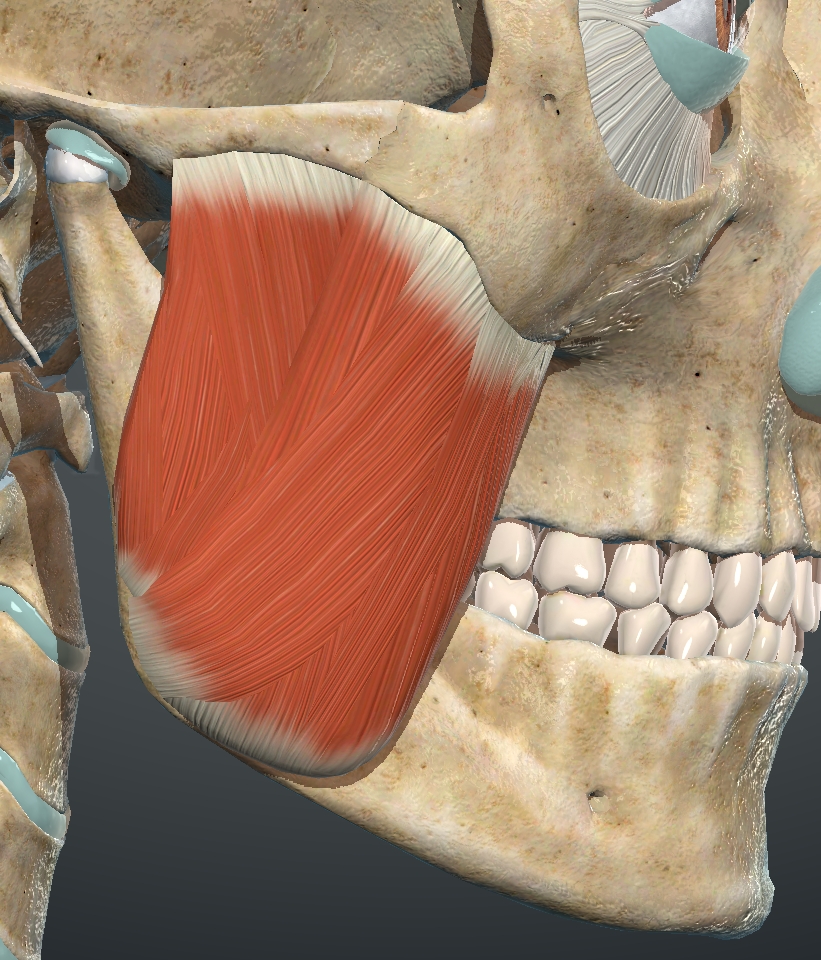
What muscle is this?
Masseter muscle
Origin: Zygomatic arch
Insertion: Branch of the mandible
Innervation: Masseteric nerve (branch of mandibular nerve V3)
Action:
Bilateral Contraction: elevation and protraction of the mandible
Unilateral Contraction: moves the mandible ipsilaterally
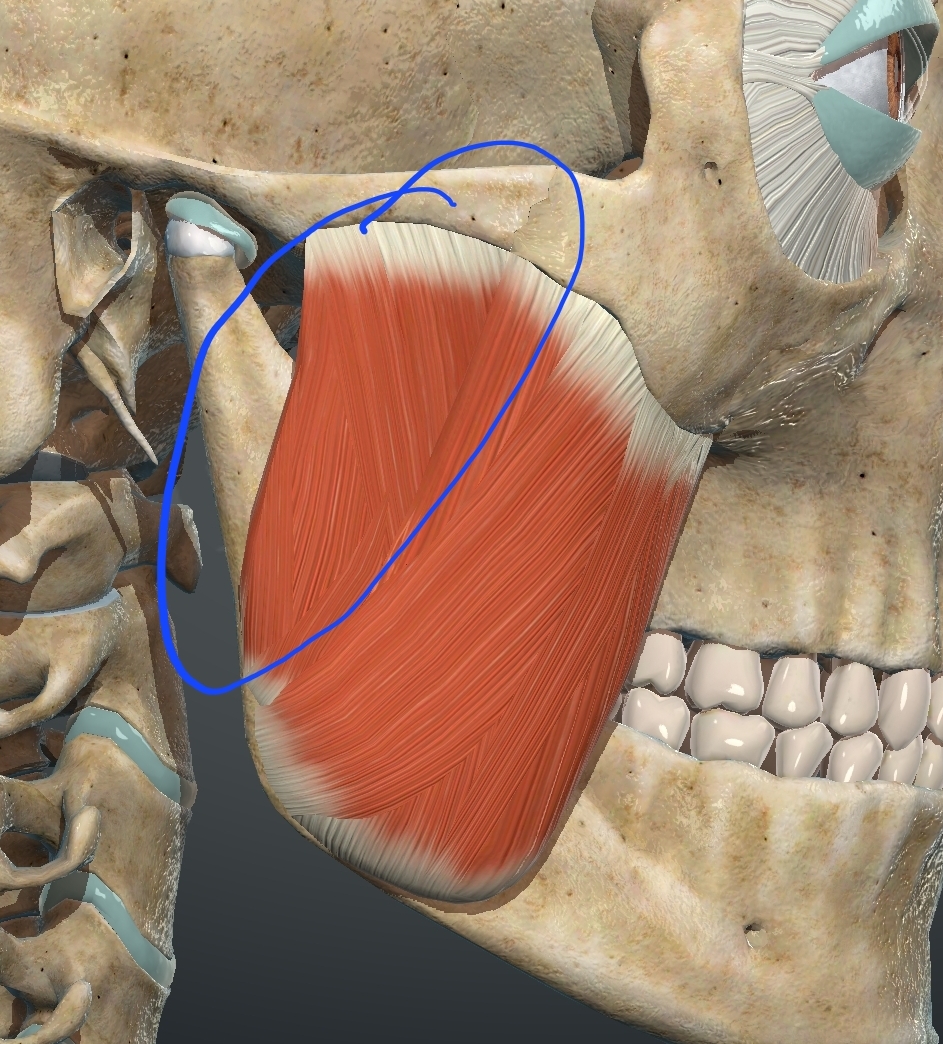
What muscle is this?
Deep part of masseter muscle
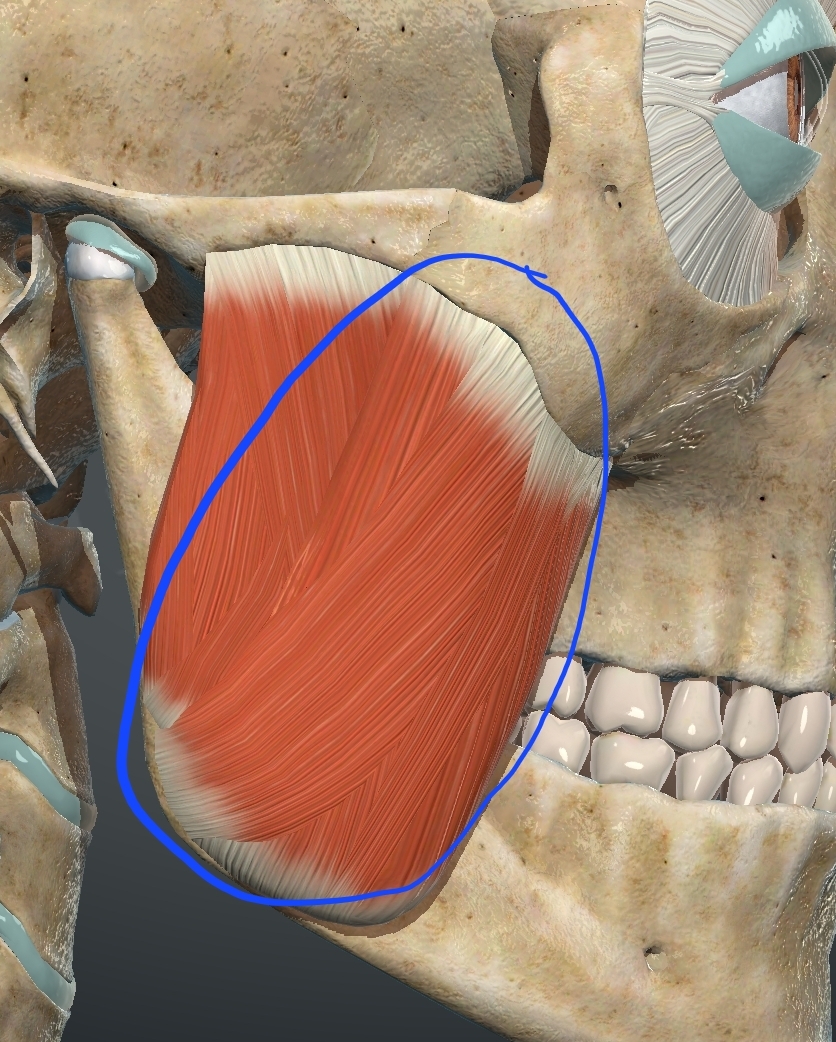
What muscle is this?
Superficial part of masseter muscle
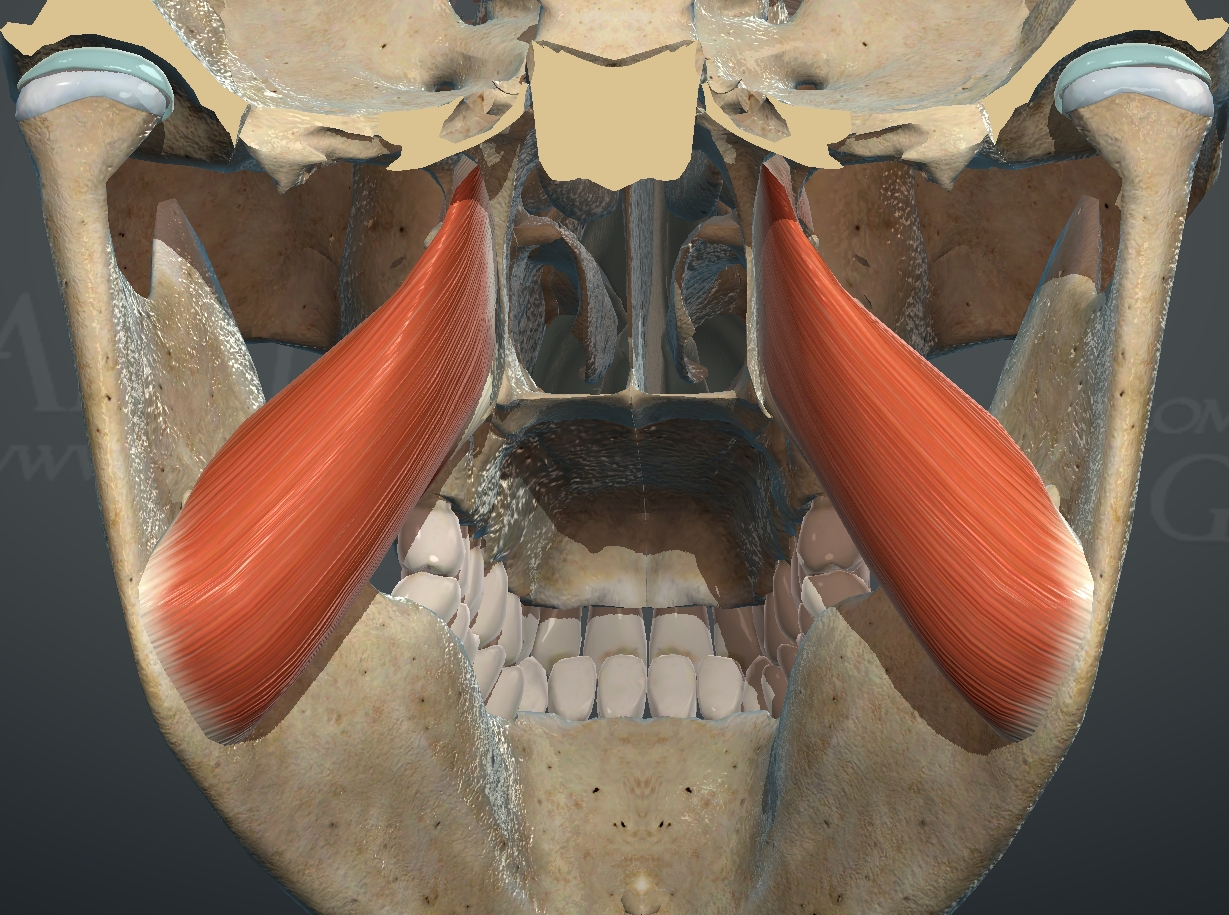
What muscle is this?
Medial pterygoid muscle
Origin: Pterygoid fossa and lateral lamina of the pterygoid process
Insertion: Angle of the mandible
Innervation: Medial pterygoid nerve (branch of mandibular nerve V3)
Action:
Bilateral Contraction: elevation and protraction of the mandible
Unilateral Contraction: displaces the mandible contralaterally
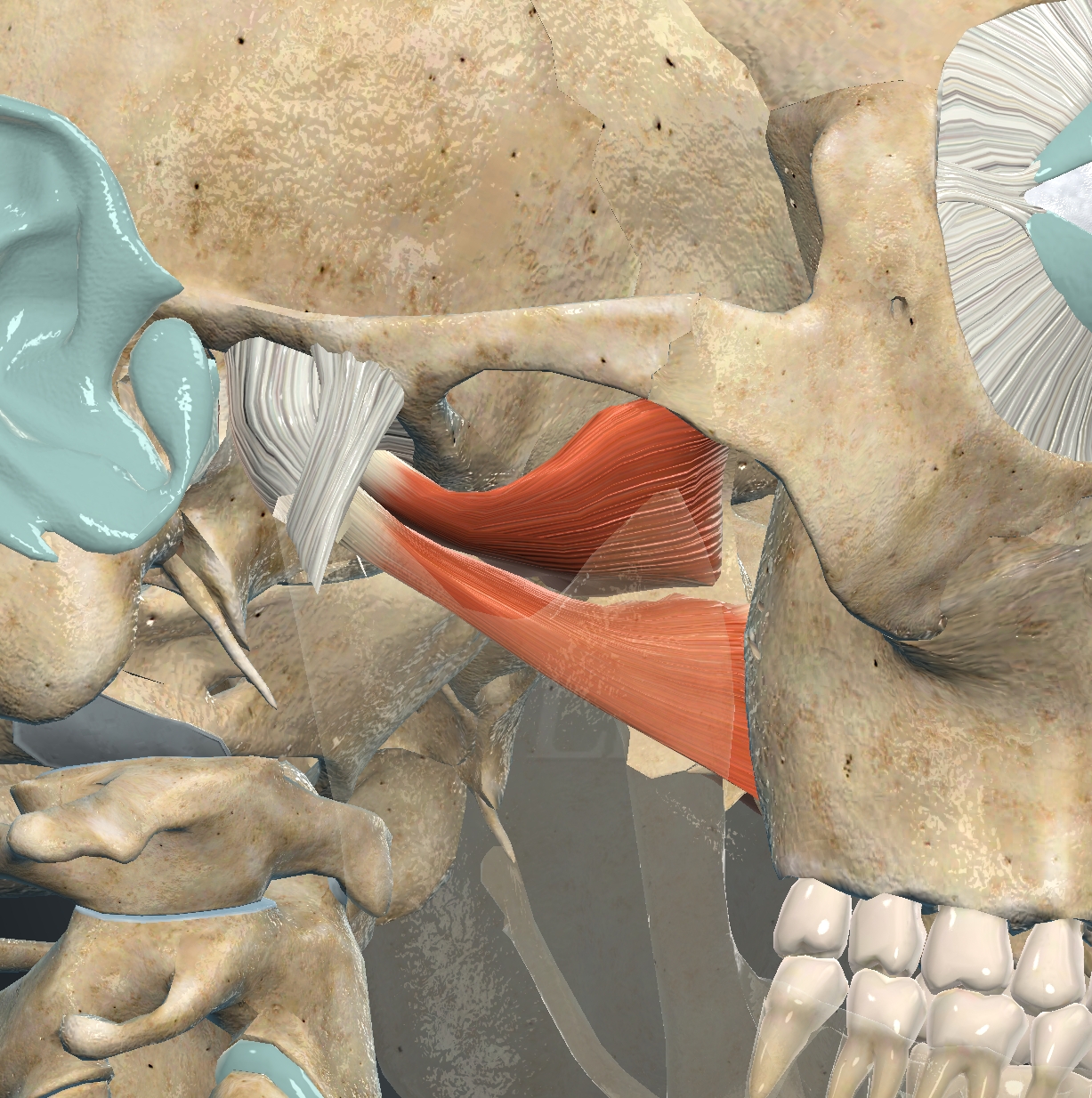
What muscle is this?
Lateral pterygoid muscle
Origin: Infratemporal crest and external surface of the lateral lamina of the pterygoid process
Insertion: Articular disc and condylar process of the mandible
Innervation: Lateral pterygoid nerve (branch of mandibular nerve V3)
Action:
Bilateral Contraction: Initiates mouth opening movement (protraction of the mandible)
Unilateral Contraction: Displaces the mandible contralaterally
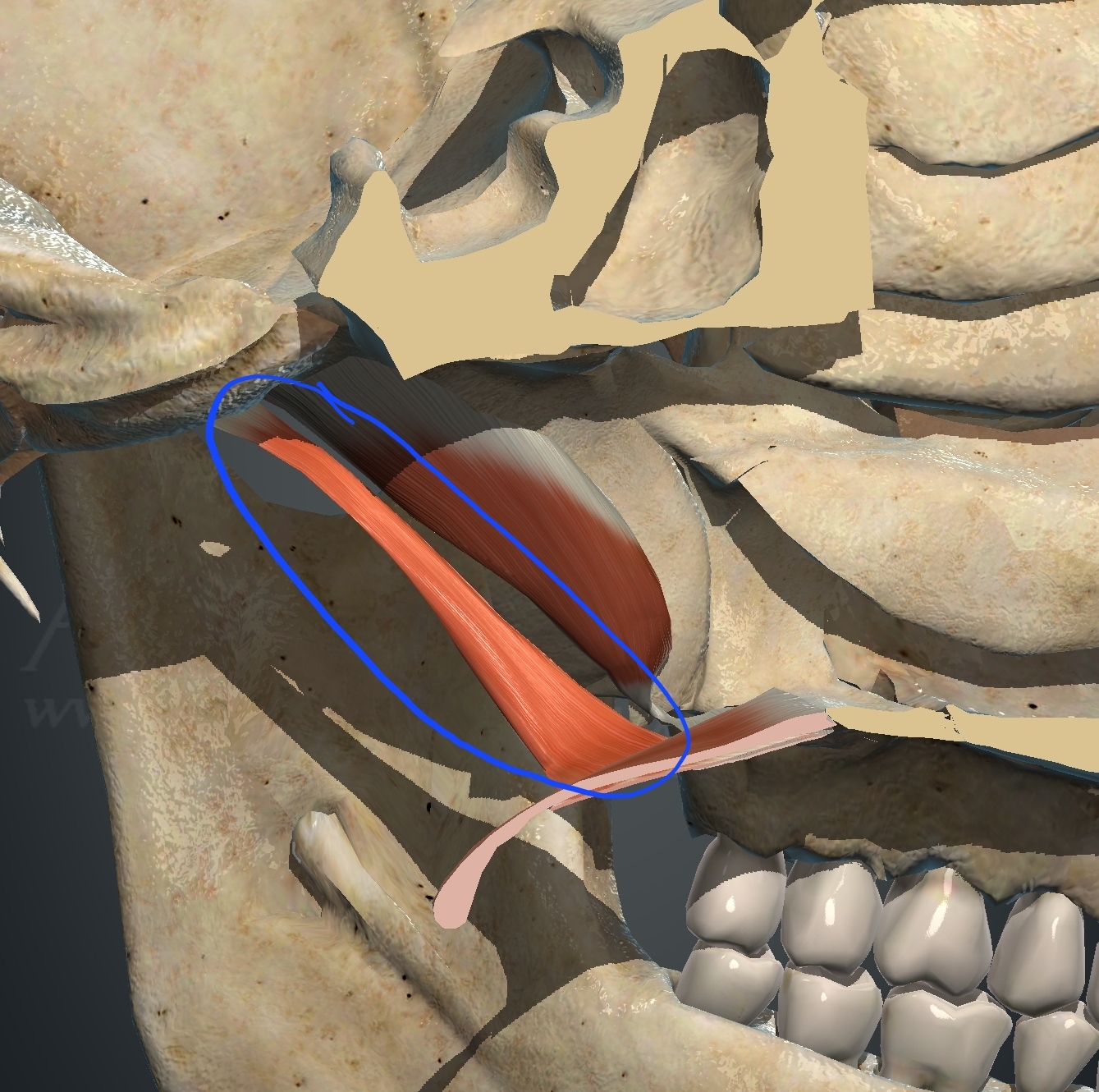
What muscle is this?
Levator veli palatini muscle
Origin: Petrosal part of the temporal bone and cartilage of the auditory tube
Insertion: Palatine aponeurosis
Innervation: Pharyngeal plexus (IX and X)
Action: Tightens and elevates the soft palate, narrows the isthmus of fauces and opens the lumen of the auditory tube
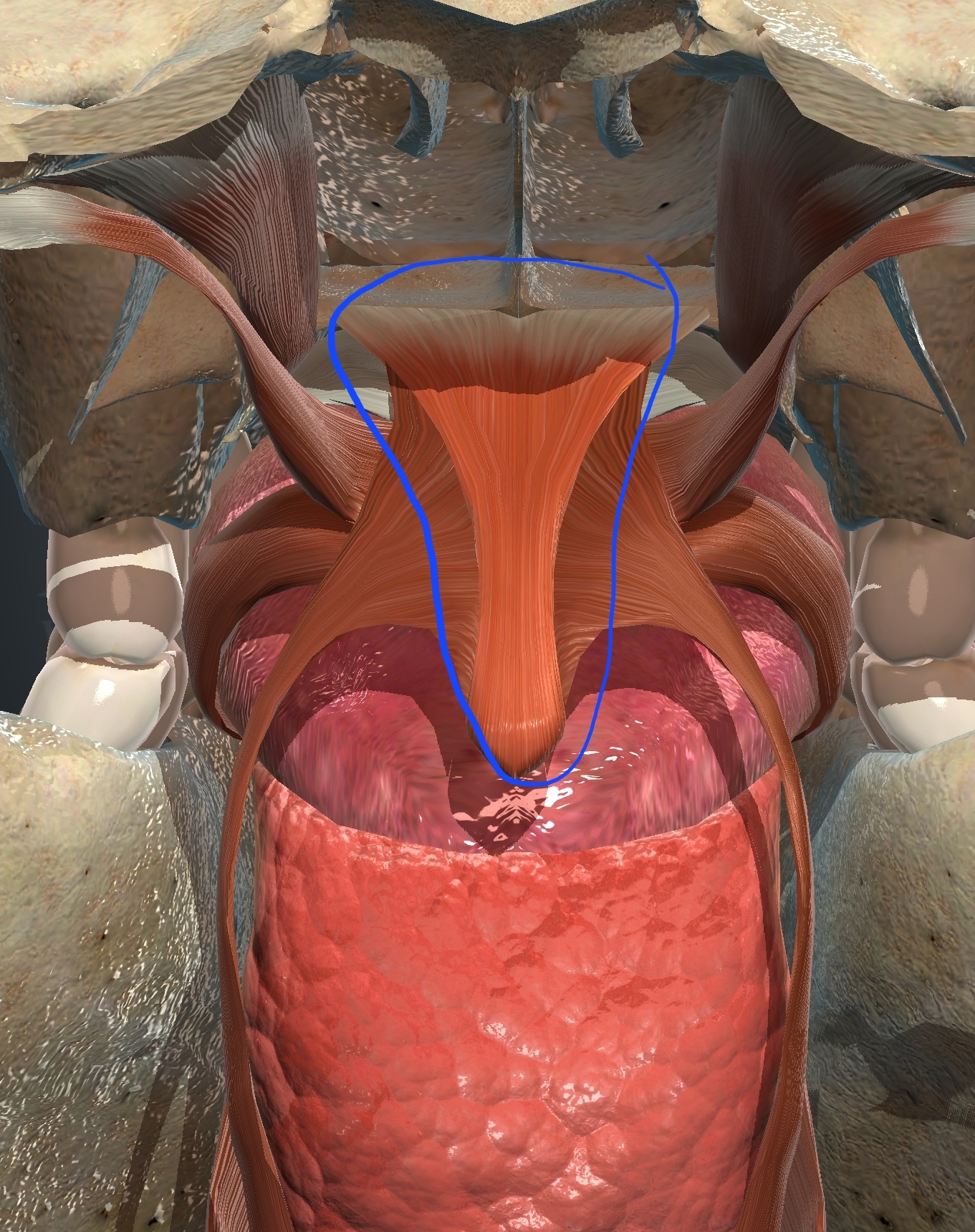
What muscle is this?
Uvulae muscle
Origin: Palatine aponeurosis
Insertion: Uvula stroma
Innervation: Pharyngeal plexus (X)
Action: Elevates the uvula
What muscle is this?
Superior Pharyngeal Constrictor
Origin:
Insertion:
Innervation:
Action:
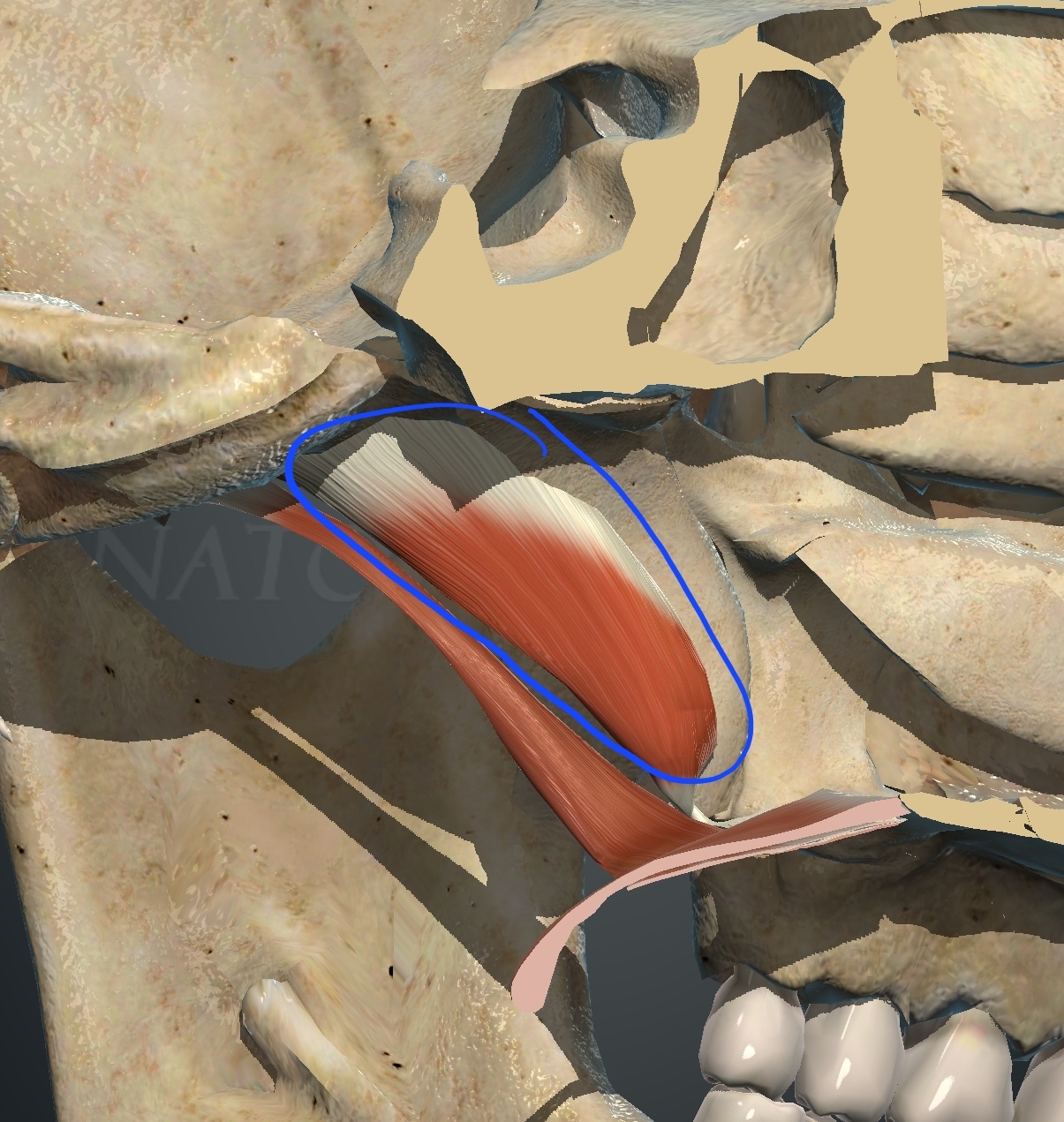
What muscle is this?
Tensor veli palatini muscle
Origin: Sphenoid spine and auditory tube
Insertion: Palatine aponeurosis
Innervation: Nerve of the tensor veli palatini muscle (branch of the mandibular nerve)
Action: Tightens the soft palate and opens the lumen of the auditory tube
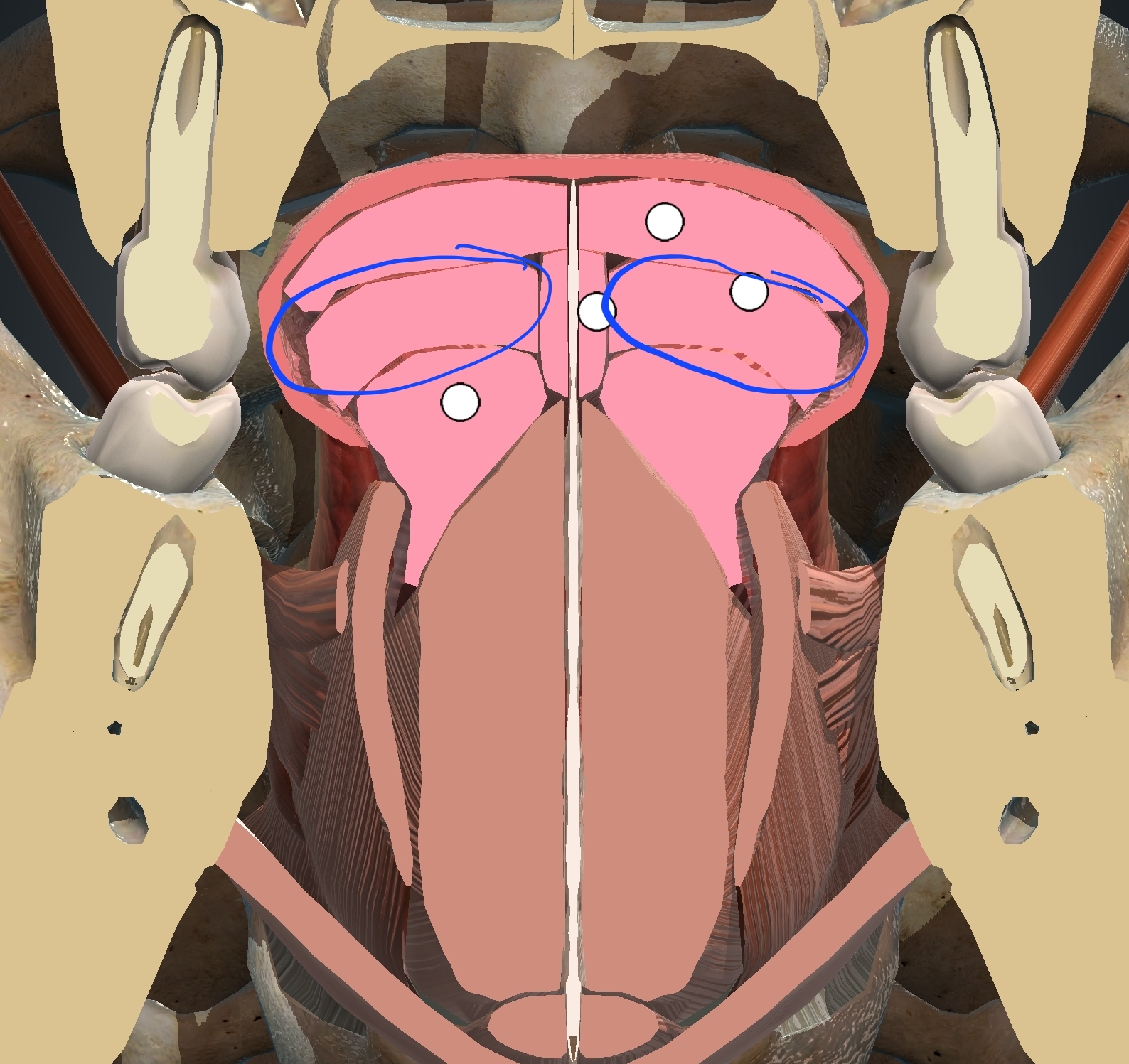
What muscle is this?
Transverse muscle of the tongue
Origin: Lingual septum and lateral border of tongue
Insertion: Lateral edge of the tongue and lingual aponeurosis
Innervation: Hypoglossal nerve (XII)
Action: Narrows and elongates the tongue
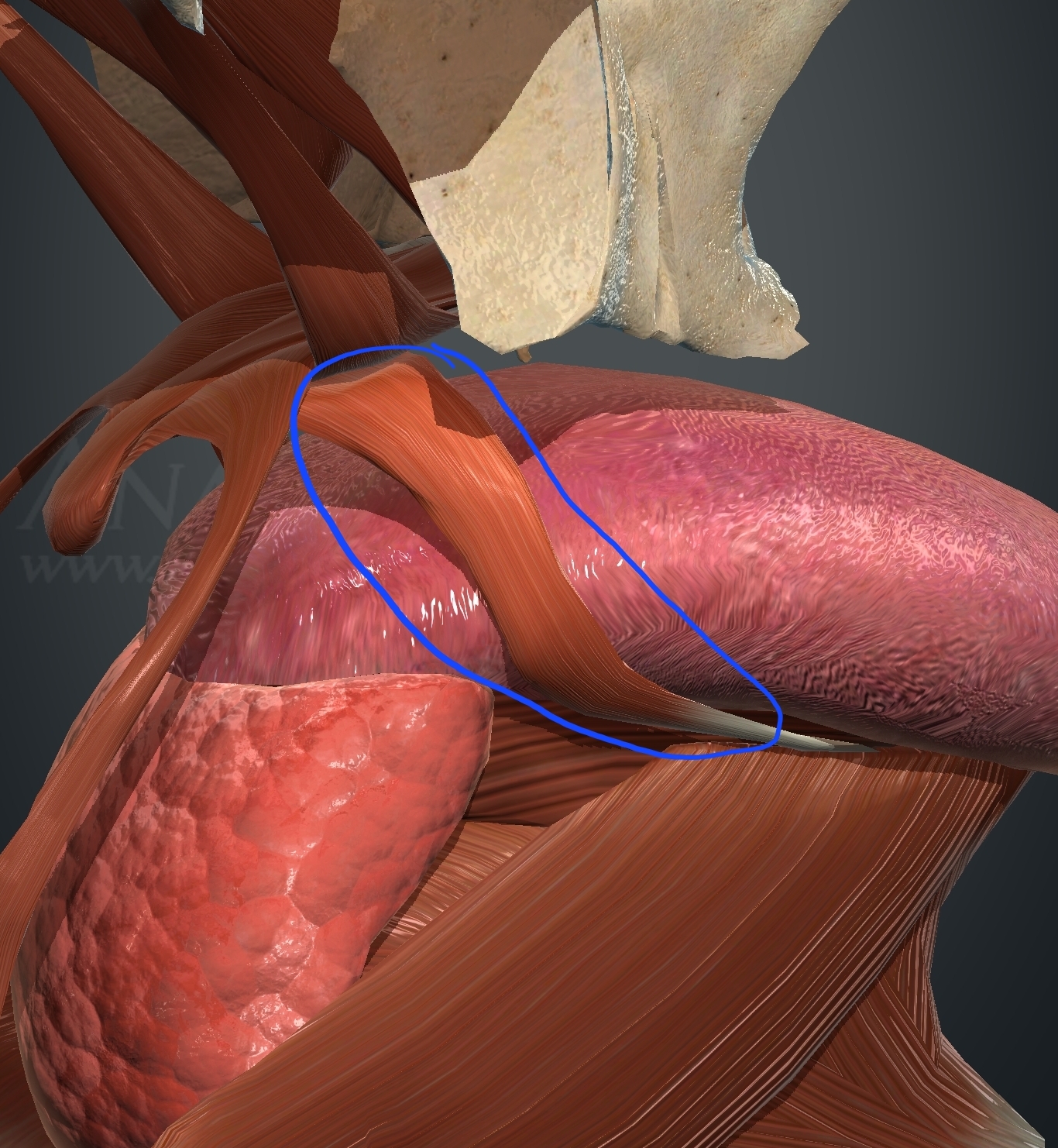
What muscle is this?
Palatoglossus muscle
Origin: Palatine aponeurosis
Insertion: Intrinsic muscles (intertwined especially with the transverse lingualis muscle)
Innervation: Hypoglossal nerve (XII), vagus nerve (X), and cranial root of accessory nerve (XI)
Action: Elevates the base of the tongue and depresses the palate, while producing a narrowing of the isthmus of the fauces
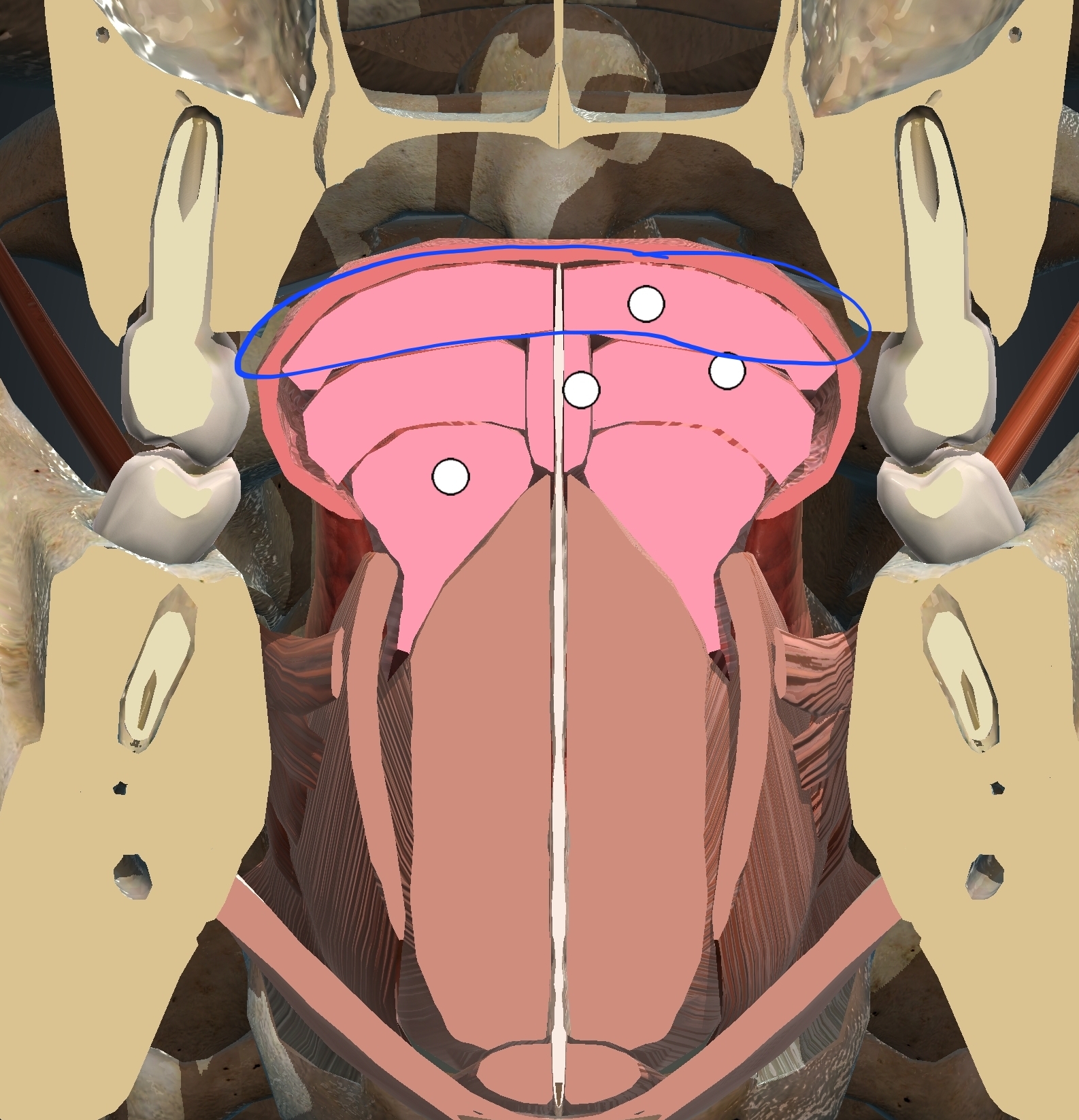
What muscle is this?
Superior longitudinal muscle of the tongue
Origin: Lingual apex
Insertion: Lingual root
Innervation: Hypoglossal nerve (XII)
Action: Retracts, thickens, and curves the tongue
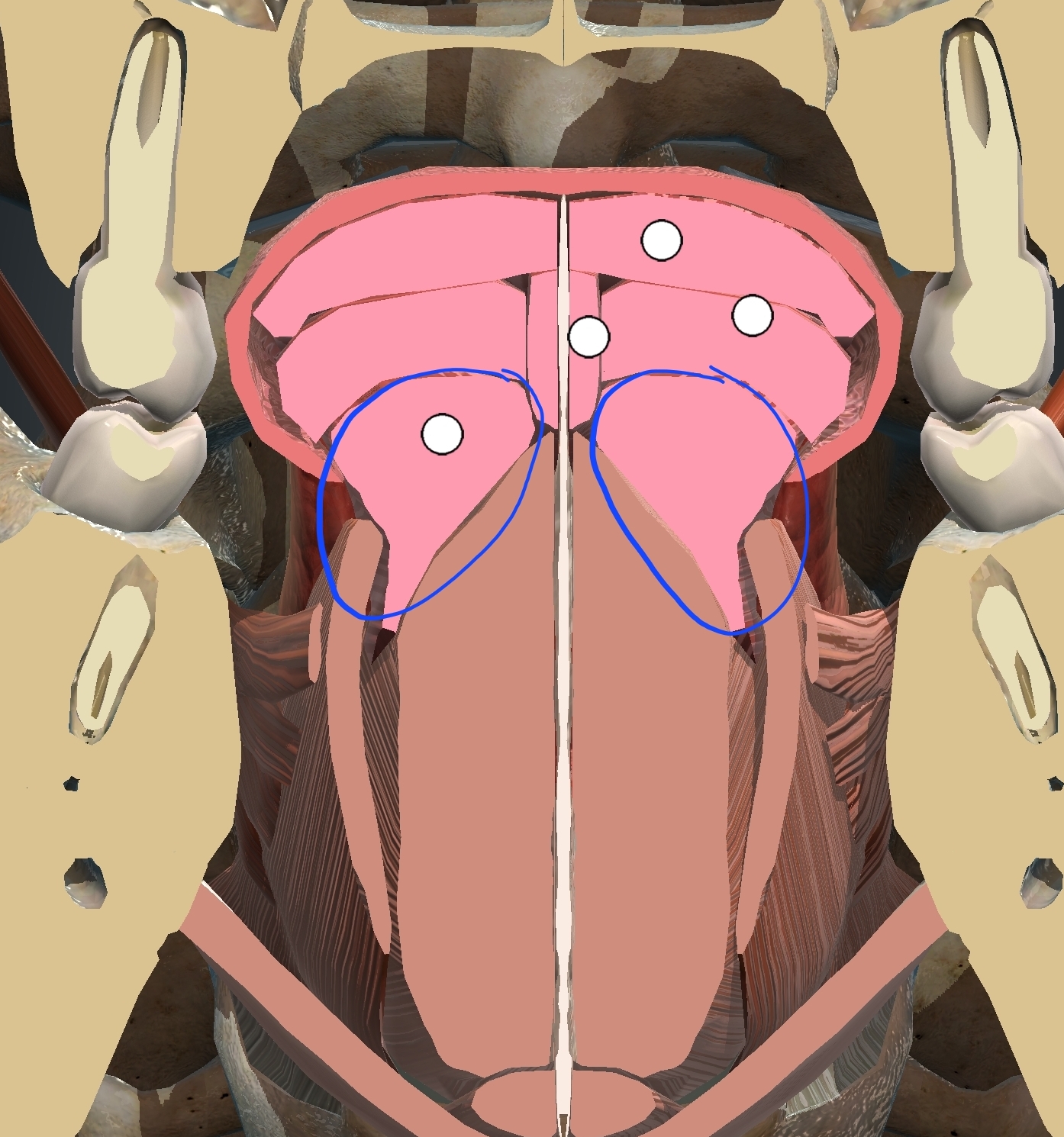
What muscle is this?
Inferior longitudinal muscle of the tongue
Origin: Lingual apex
Insertion: Lingual root
Innervation: Hypoglossal nerve (XII)
Action: Retracts, thickens, and curves the tongue
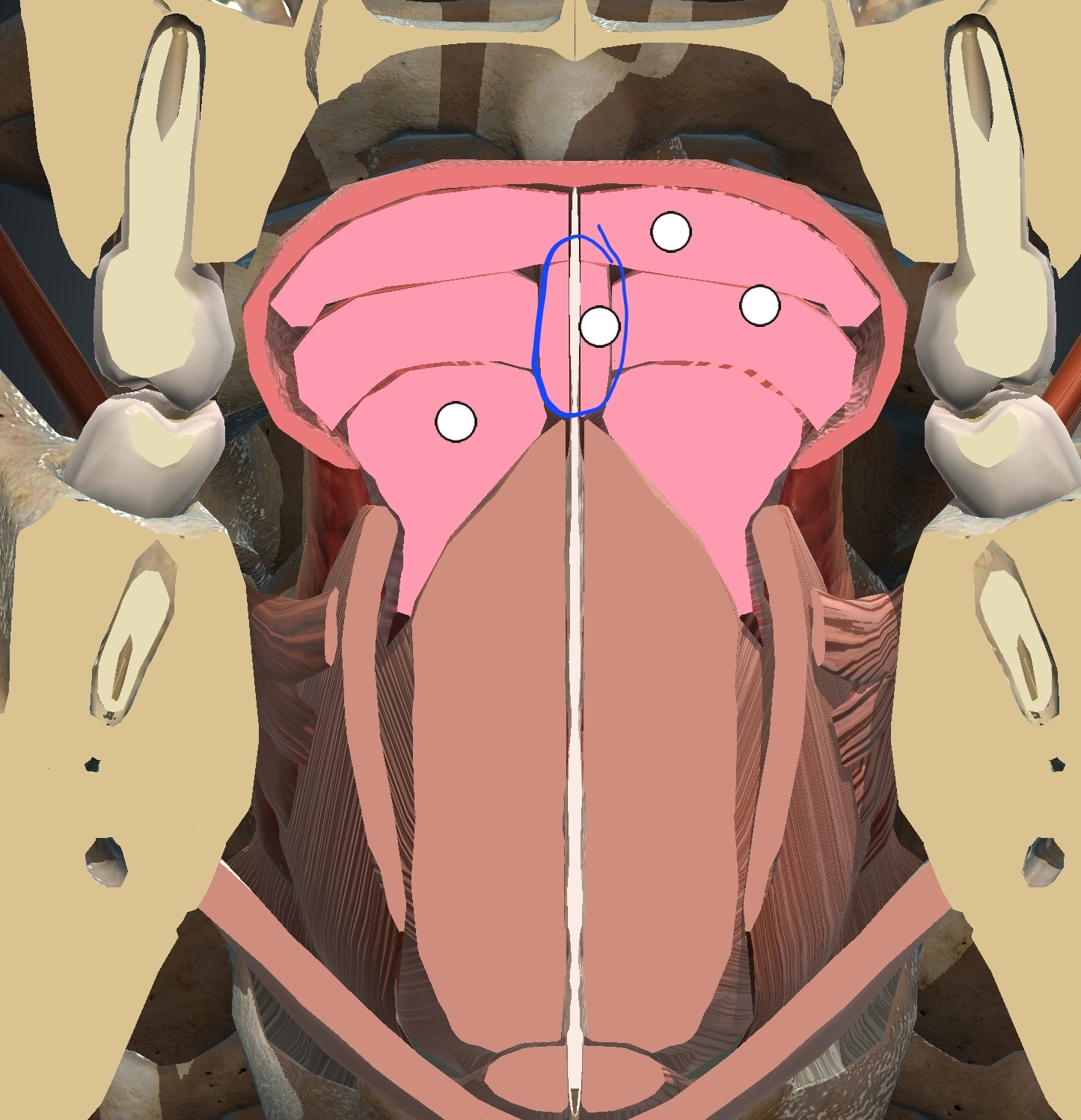
What muscle is this?
Vertical muscle of the tongue
Origin: Submucosal tissue of the dorsum of the tongue
Insertion: Submucosal tissue of the most ventral areas of the tongue
Innervation: Hypoglossal nerve (XII)
Action: Flattens and thickens the tongue
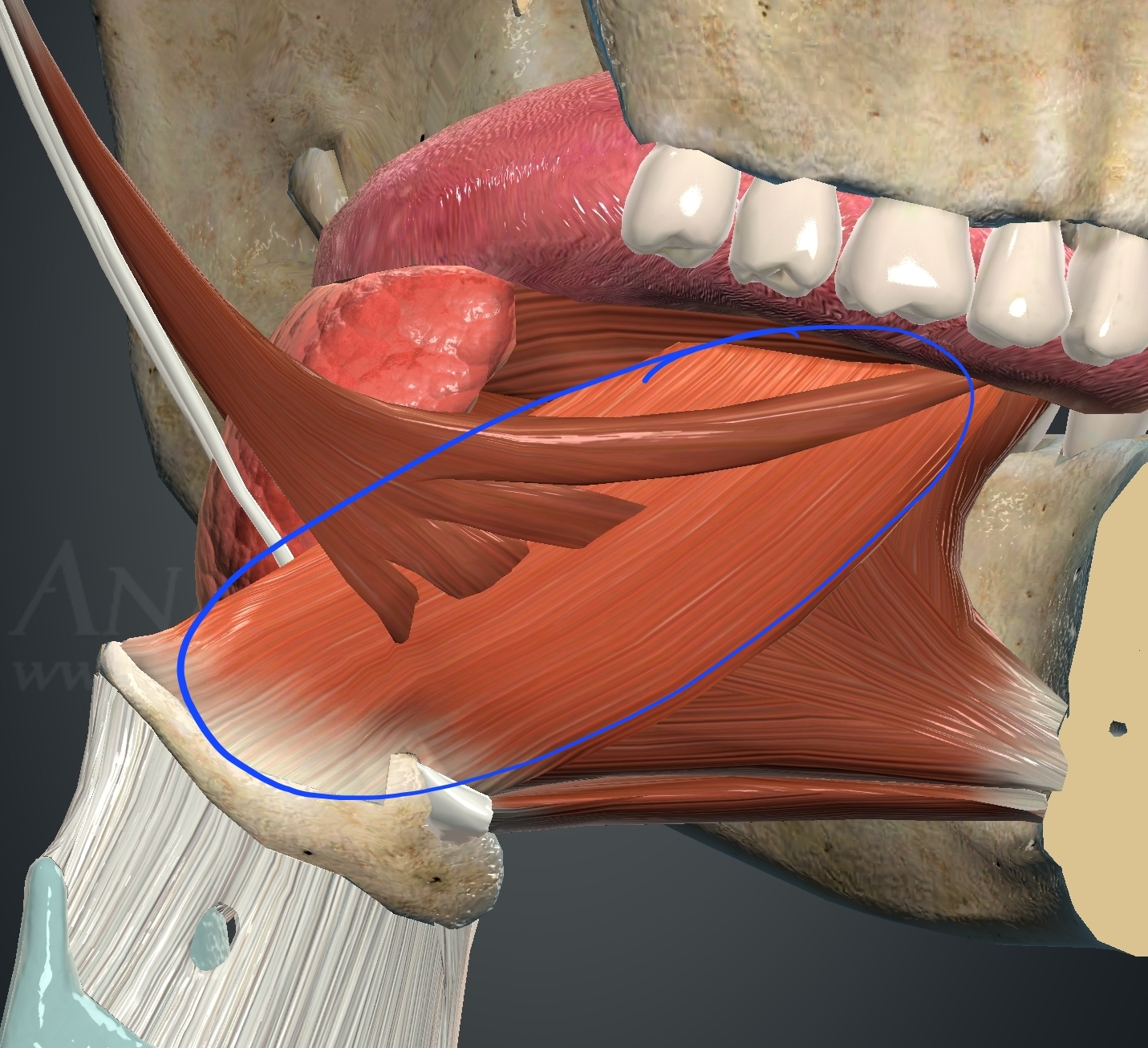
What muscle is this?
Hyoglossus muscle
Origin: Hyoid
Insertion: Lingual aponeurosis
Innervation: Hypoglossal nerve (XII)
Action: Retracts and depresses the dorsum and base of the tongue
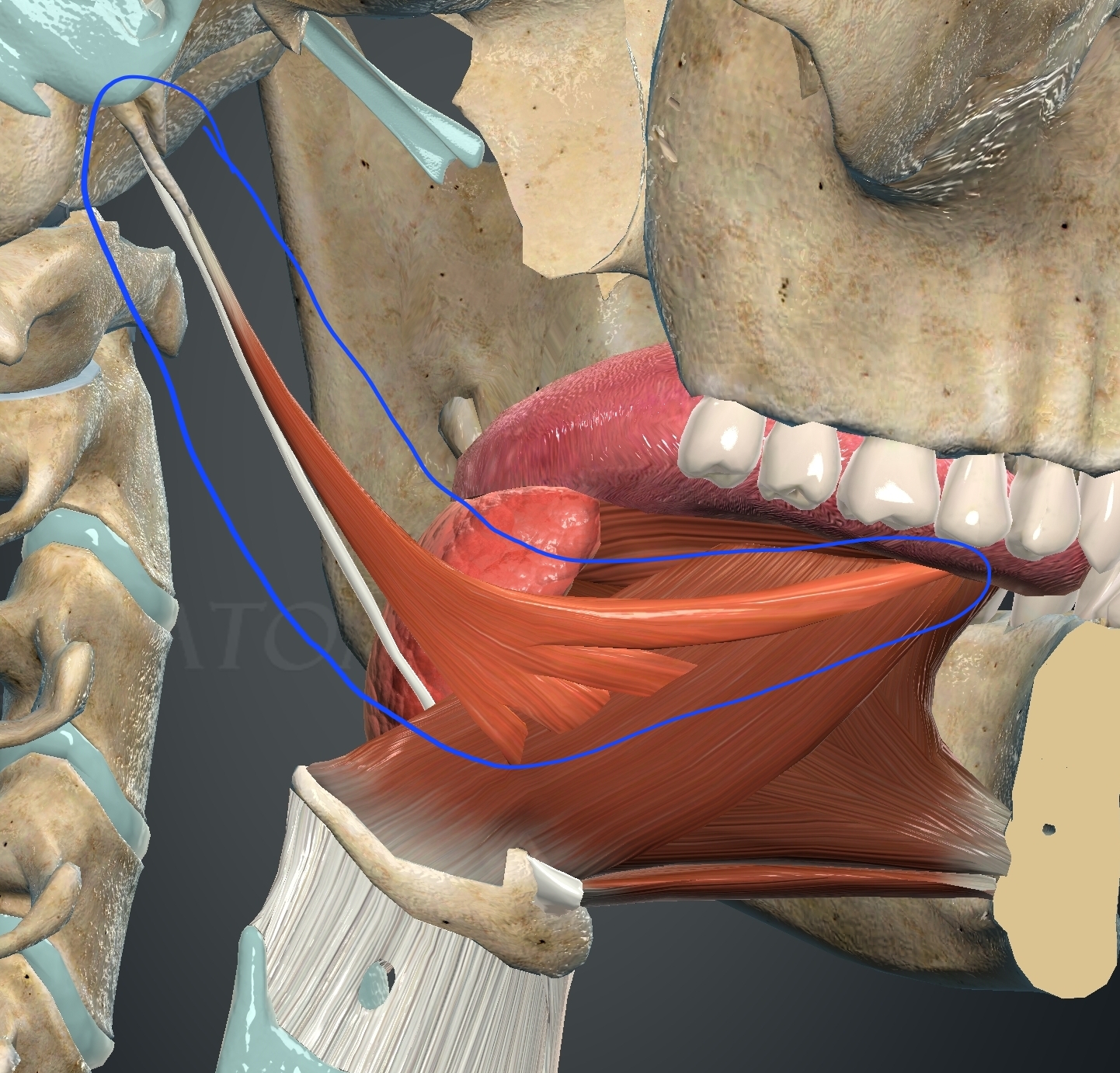
What muscle is this?
Styloglossus muscle
Origin: Styloid process of the temporal bone
Insertion: Lateral wall of the pharynx
Innervation: Hypoglossal nerve (XII)
Action: Elevates the pharynx
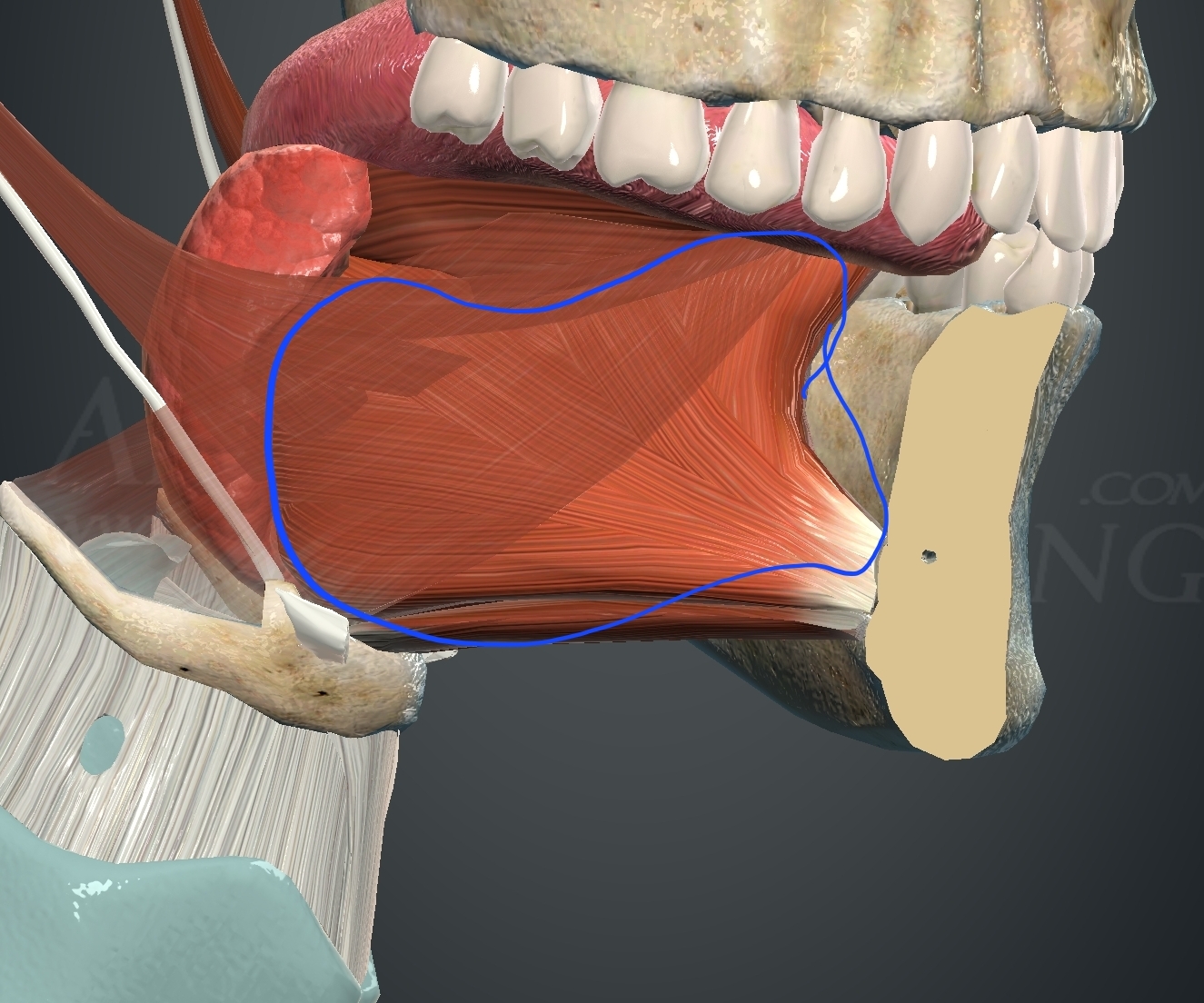
What muscle is this?
Genioglossus muscle
Origin: Superior mental spine of the mandible
Insertion: Lingual aponeurosis
Innervation: Hypoglossal nerve (XII)
Action: Protrusion and depression of the tongue (participates in tip movements)
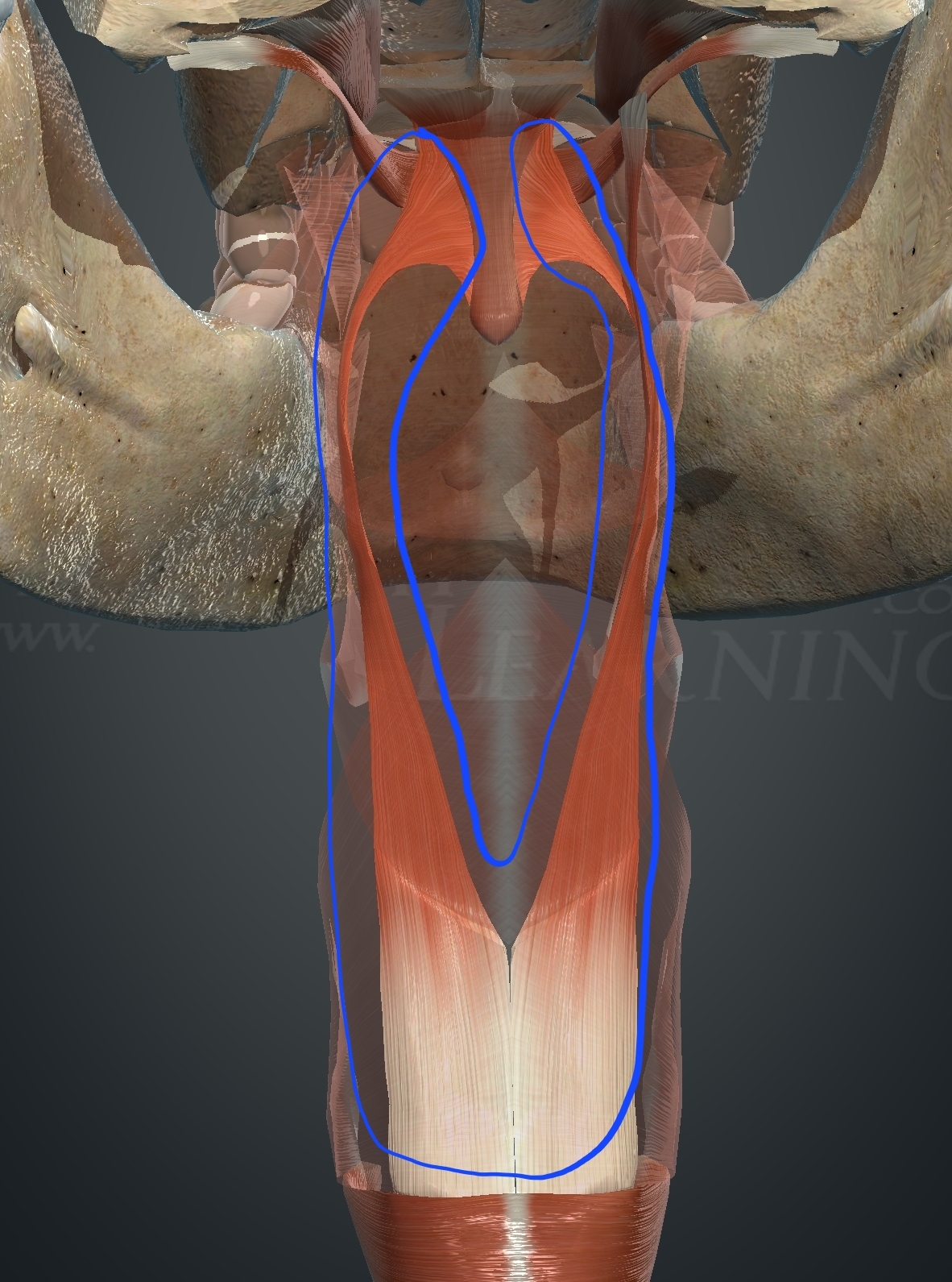
What muscle is this?
Palatopharyngeus
Origin: Palatine aponeurosis and hook of the pterygoid process
Insertion: Lateroposterior wall of the pharynx and thyroid cartilage
Innervation: Pharyngeal branches of the glossopharyngeal nerve (IX)
Action: Narrows the isthmus of fauces and lowers the soft palate
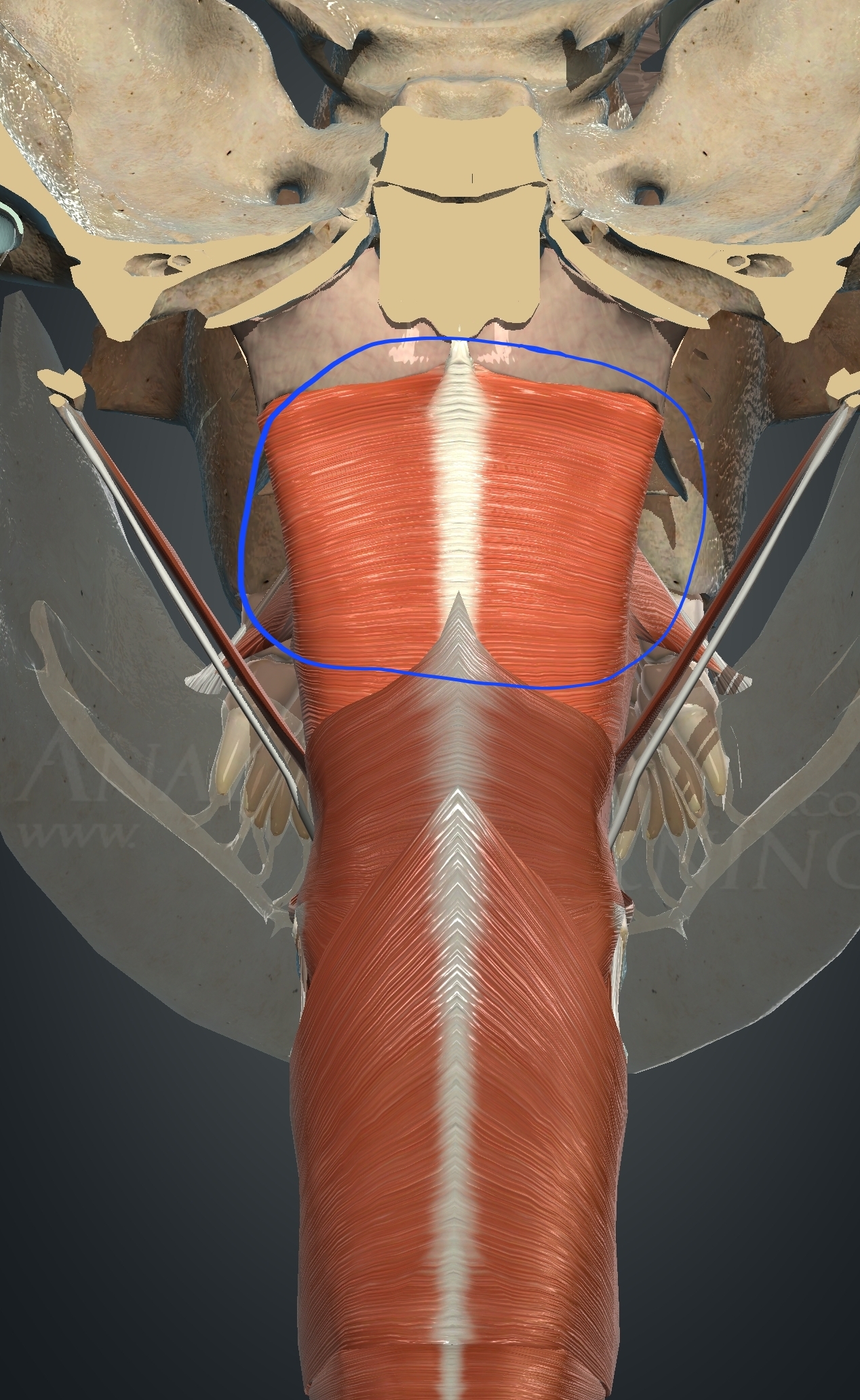
What muscle is this?
Superior Pharyngeal Constrictor
Origin: Pterygoid process and hook, pterygomandibular raphe, mylohyoid line, and lingual transverse muscle
Insertion: Pharyngobasilar membrane and pharyngeal raphe
Innervation: Pharyngeal branches of glossopharyngeal nerve (IX)
Action: Narrows the pharynx and promotes the alimentary bolus into the esophagus
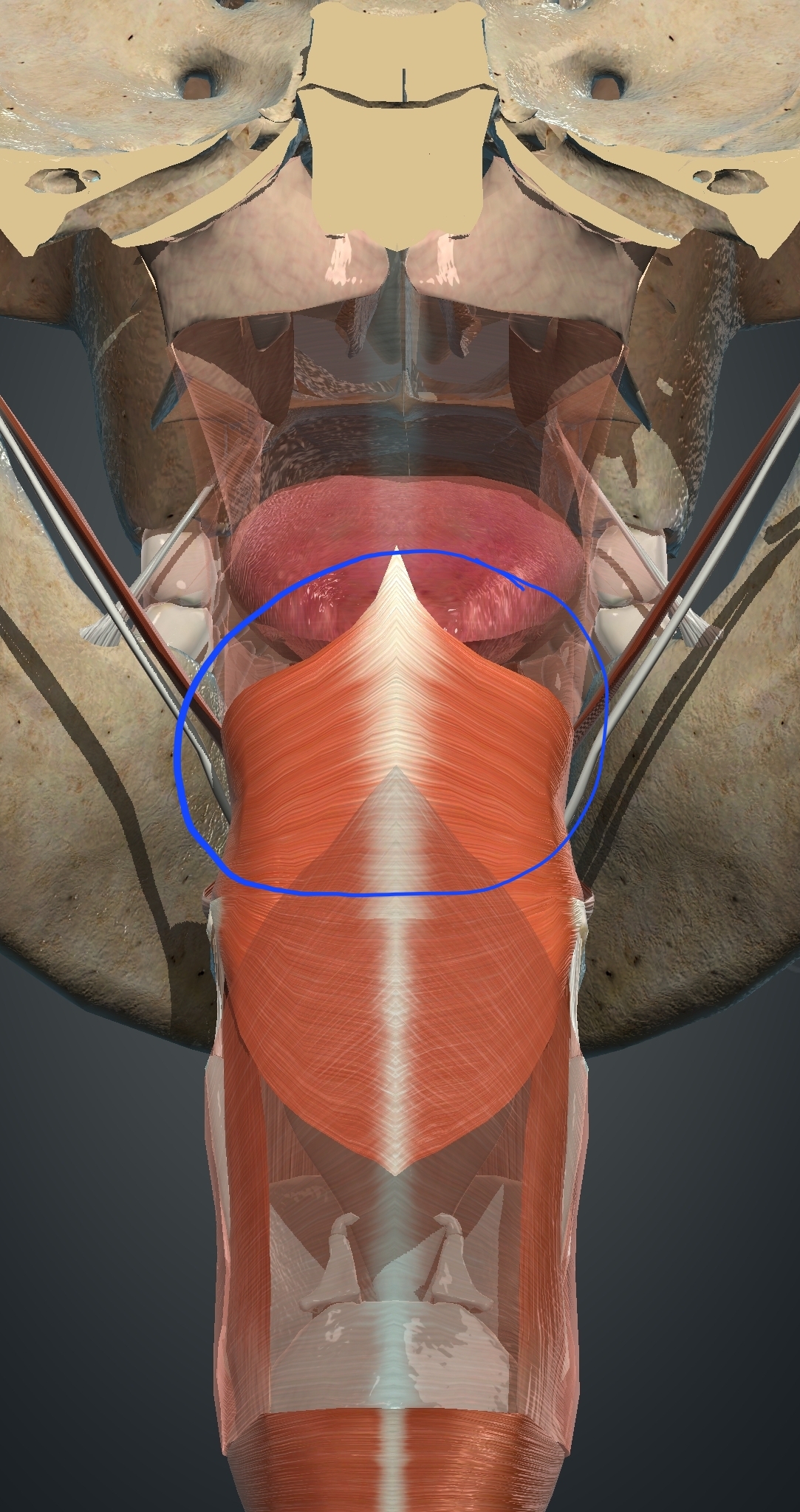
What muscle is this?
Medial Pharyngeal Constrictor
Origin: Hyoid
Insertion: Pharyngeal raphe
Innervation: Pharyngeal branches of glossopharyngeal nerve (IX) and vagus nerve (X)
Action: Narrows the pharynx and promotes the alimentary bolus into the esophagus
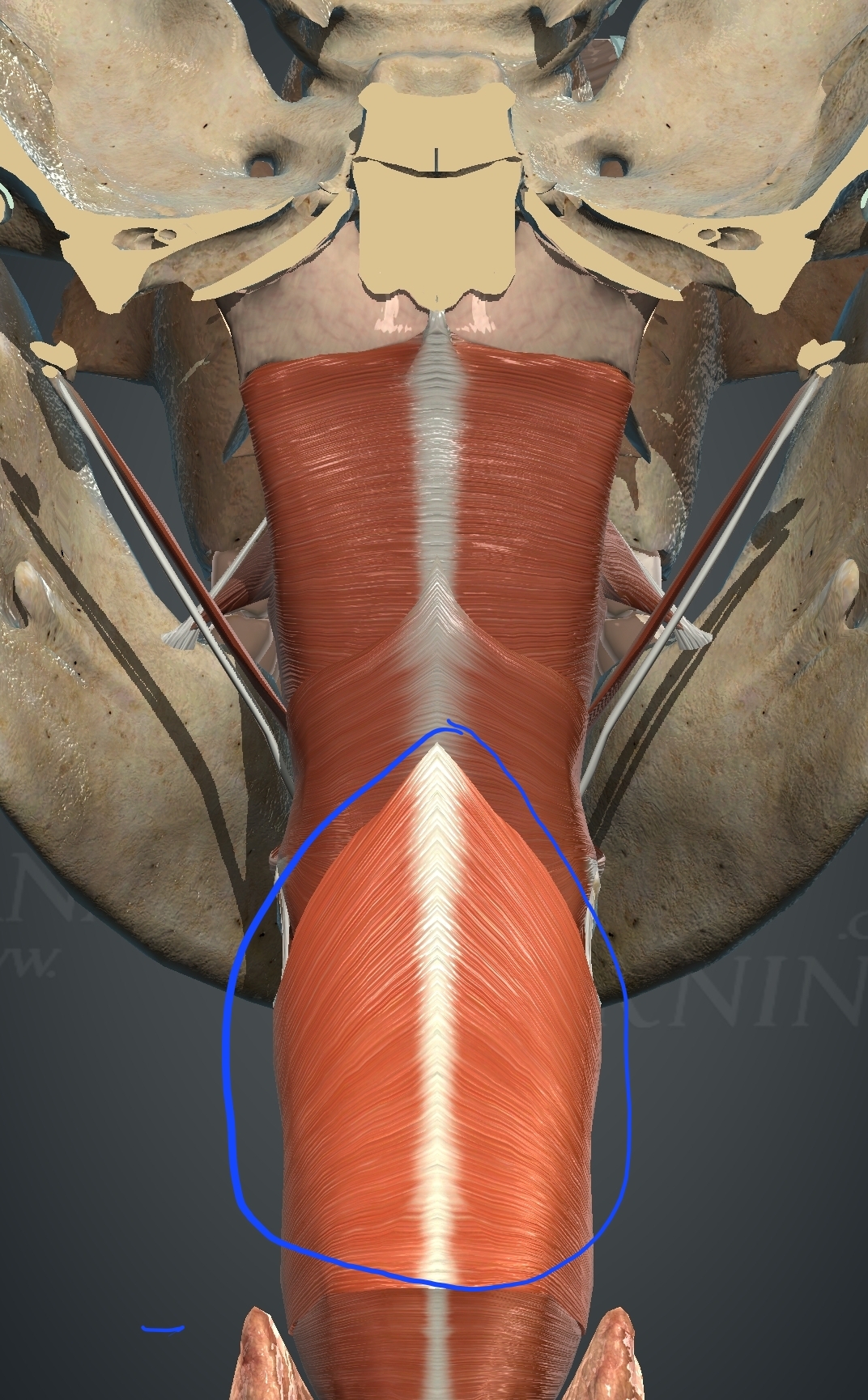
What muscle is this?
Inferior Pharyngeal Constrictor
Origin: Thyroid cartilage, cricoid cartilage and trachea
Insertion: Pharyngeal raphe
Innervation: Pharyngeal branches of vagus nerve (X)
Action: Narrows the pharynx and promotes the alimentary bolus into the esophagus
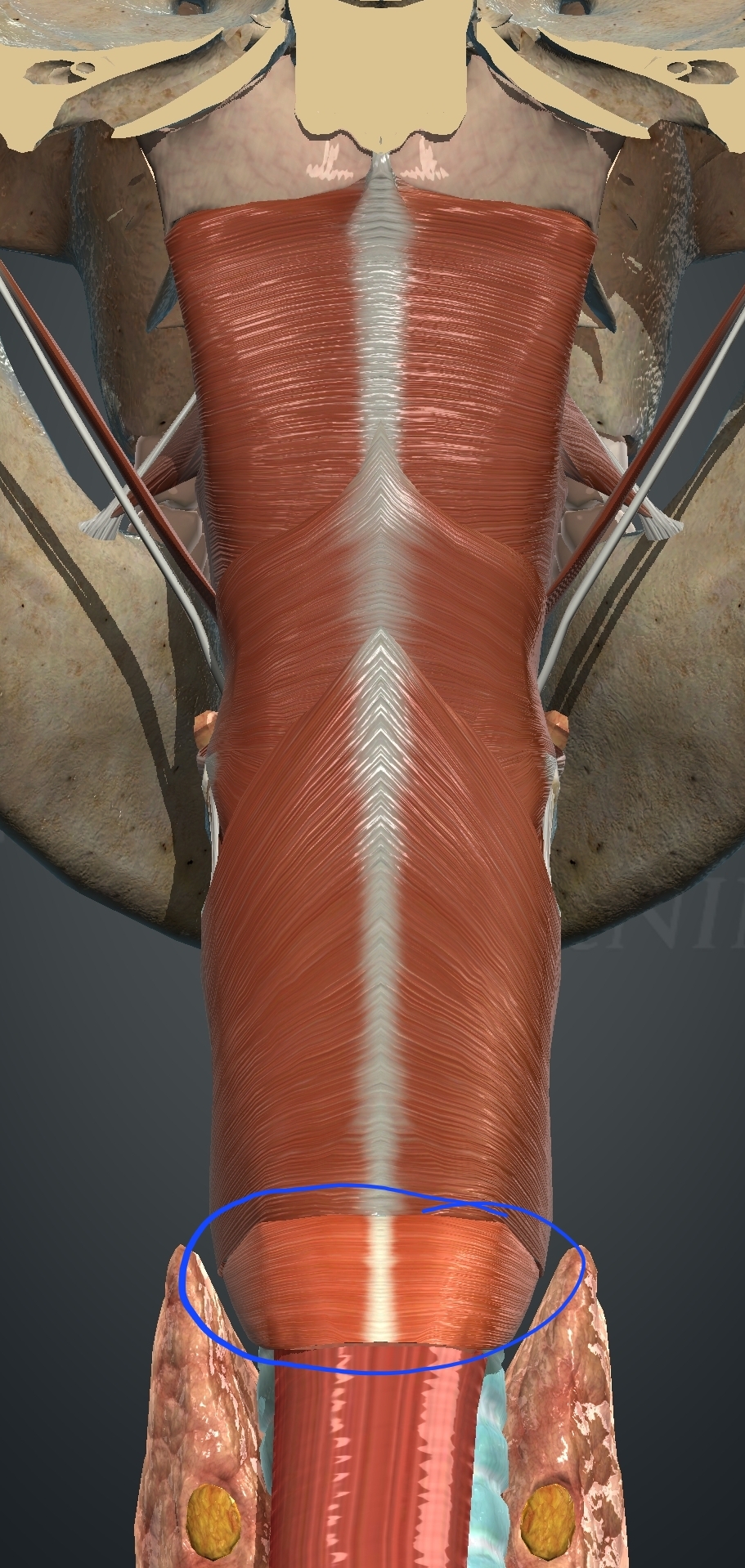
What muscle is this?
Cricopharyngeus muscle
Origin: Middle pharyngeal raphe
Insertion: Cricoid cartilage
Innervation: Pharyngeal plexus and pharyngeal branches vagus nerve (X)
Action: Upper esophageal sphincter
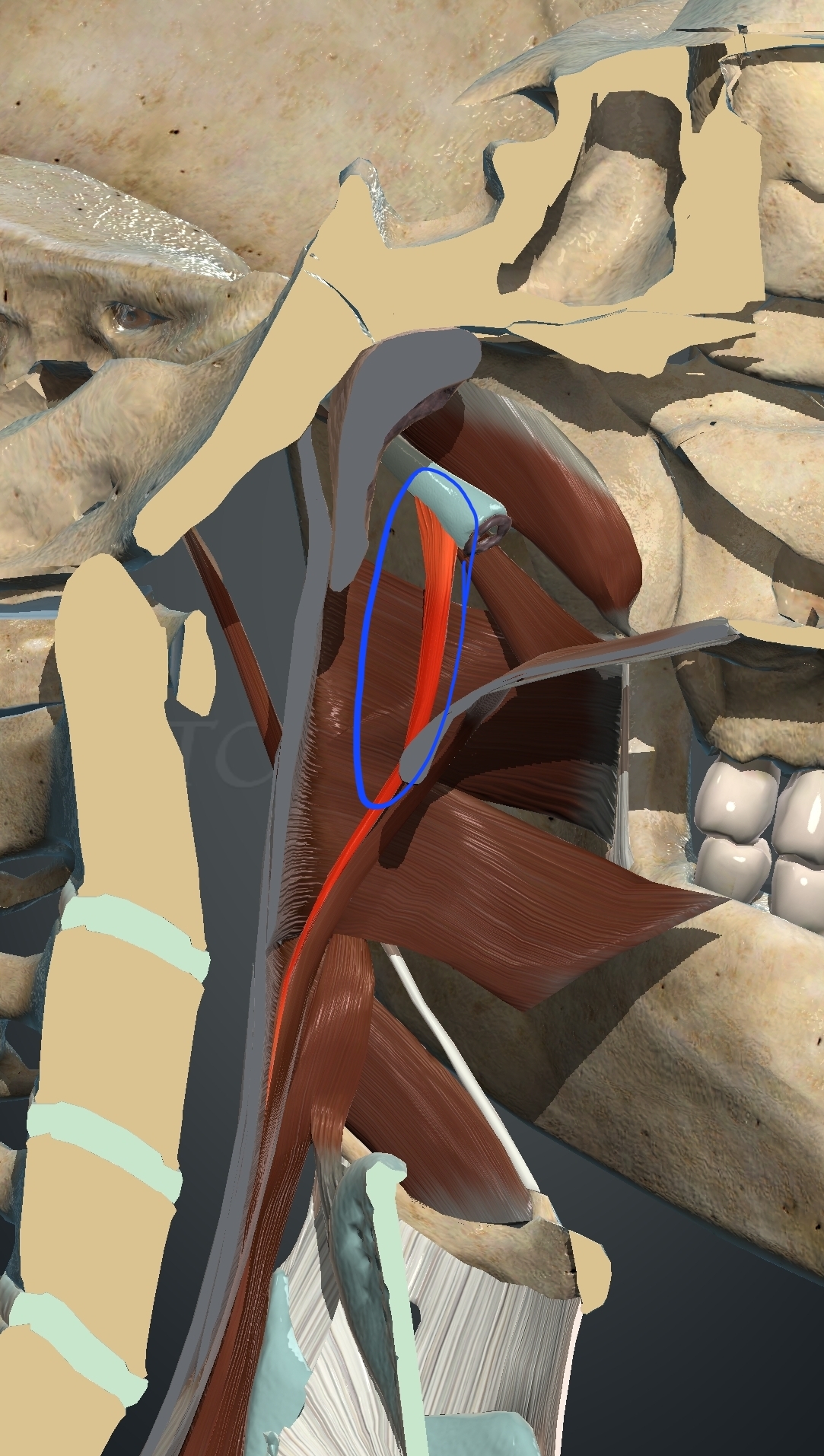
What muscle is this?
Salpingopharyngeus muscle
Origin: Cartilage of the auditory tube
Insertion: Lateral wall of the pharynx
Innervation: Pharyngeal branches of the glossopharyngeal nerve (IX)
Action: Elevates the pharynx and opens the auditory tube
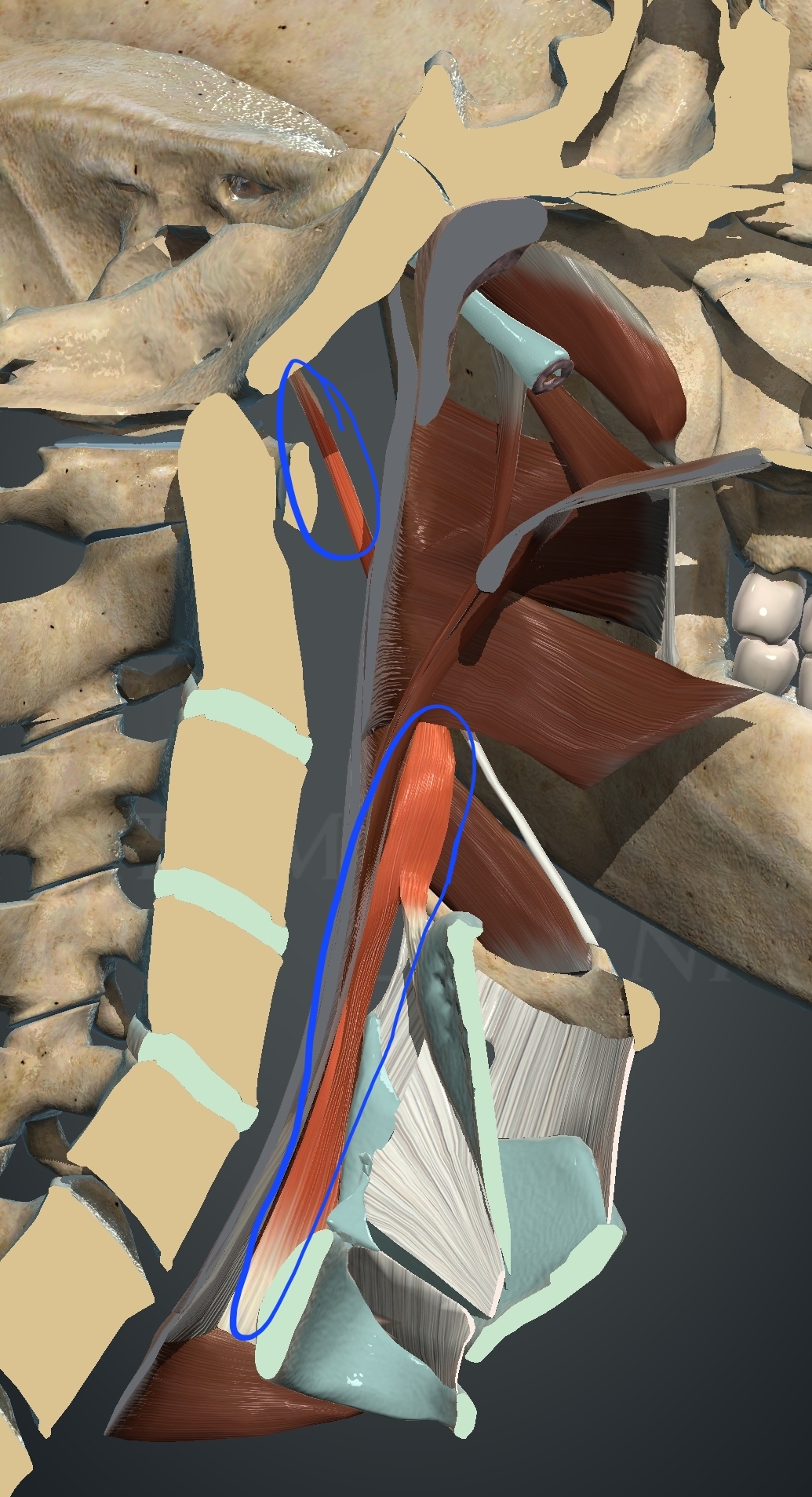
What muscle is this?
Stylopharyngeus muscle
Origin: Styloid process of the temporal bone
Insertion: Lateral wall of the pharynx
Innervation: Branch of the stylopharyngeus muscle of the glossopharyngeal nerve (IX)
Action: Elevates the pharynx
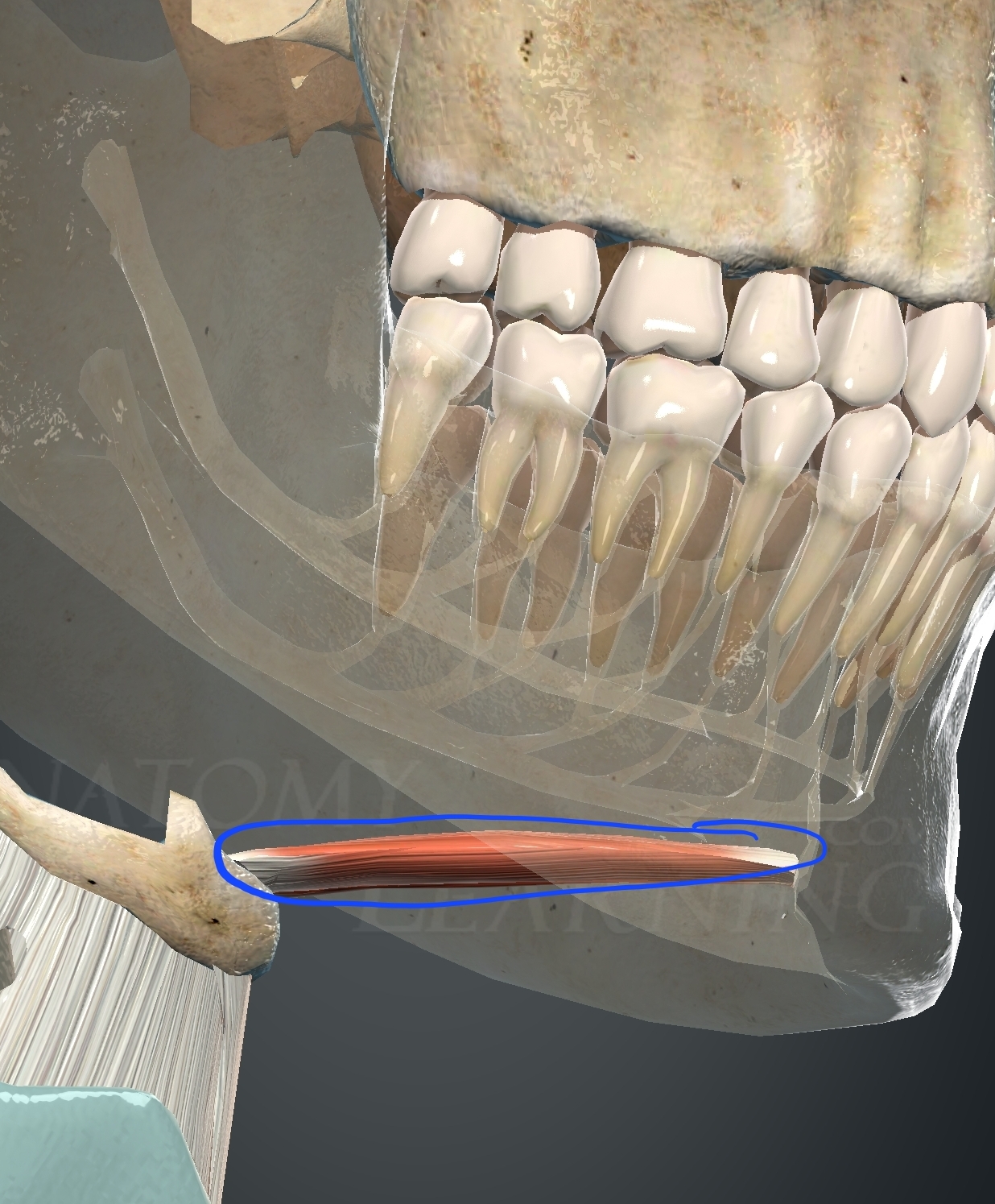
What muscle is this?
Geniohyoid muscle
Origin: Inferior mental spine
Insertion: Hyoid
Innervation: C1 through hypoglossal nerve (XII)
Action:
Fixed Mandible: elevates and moves the hyoid forward
Fixed Hyoid: depresses and retracts the mandible
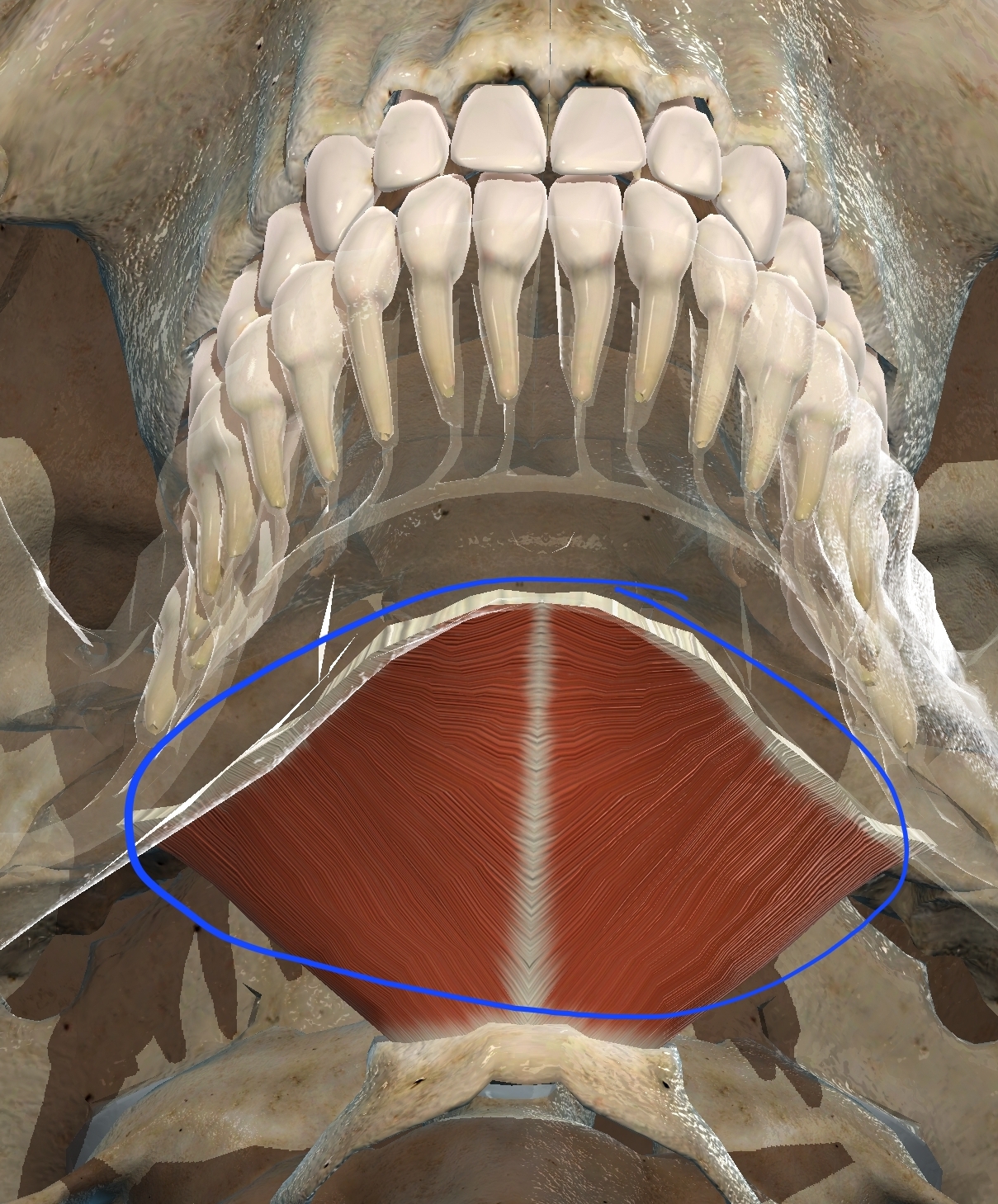
What muscle is this?
Mylohyoid muscle
Origin: Mylohyoid line of the jaw
Insertion: Hyoid
Innervation: Mylohyoid nerve (branch of mandibular nerve V3)
Action: Supports and elevates the floor of the mouth, elevates and moves forward the hyoid
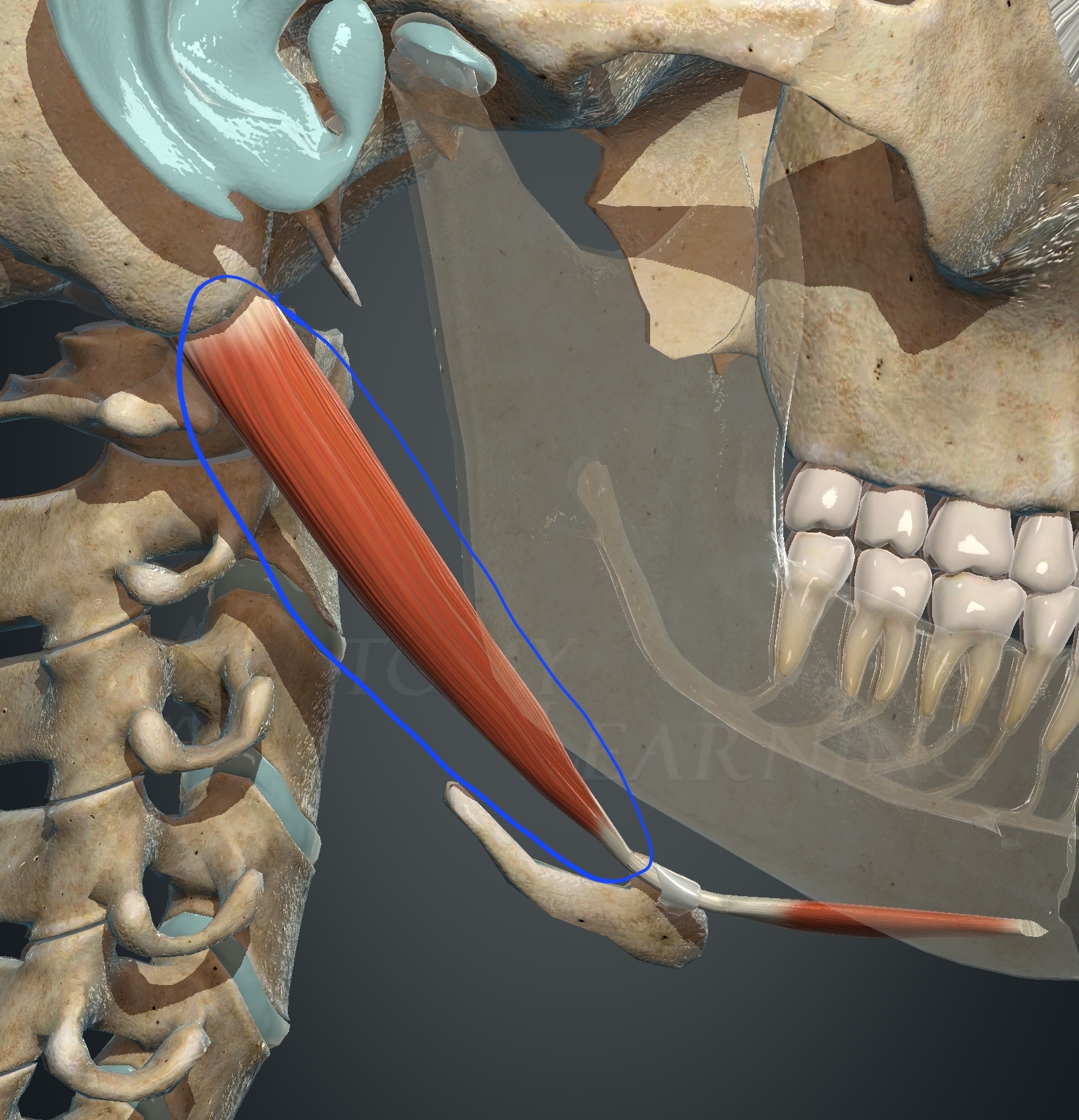
What muscle is this?
Posterior Belly of the Digastric muscle
Origin: Mastoid process
Insertion: Intermediate tendon
Innervation: Facial nerve (VII)
Action: Elevates the hyoid, depresses the mandible
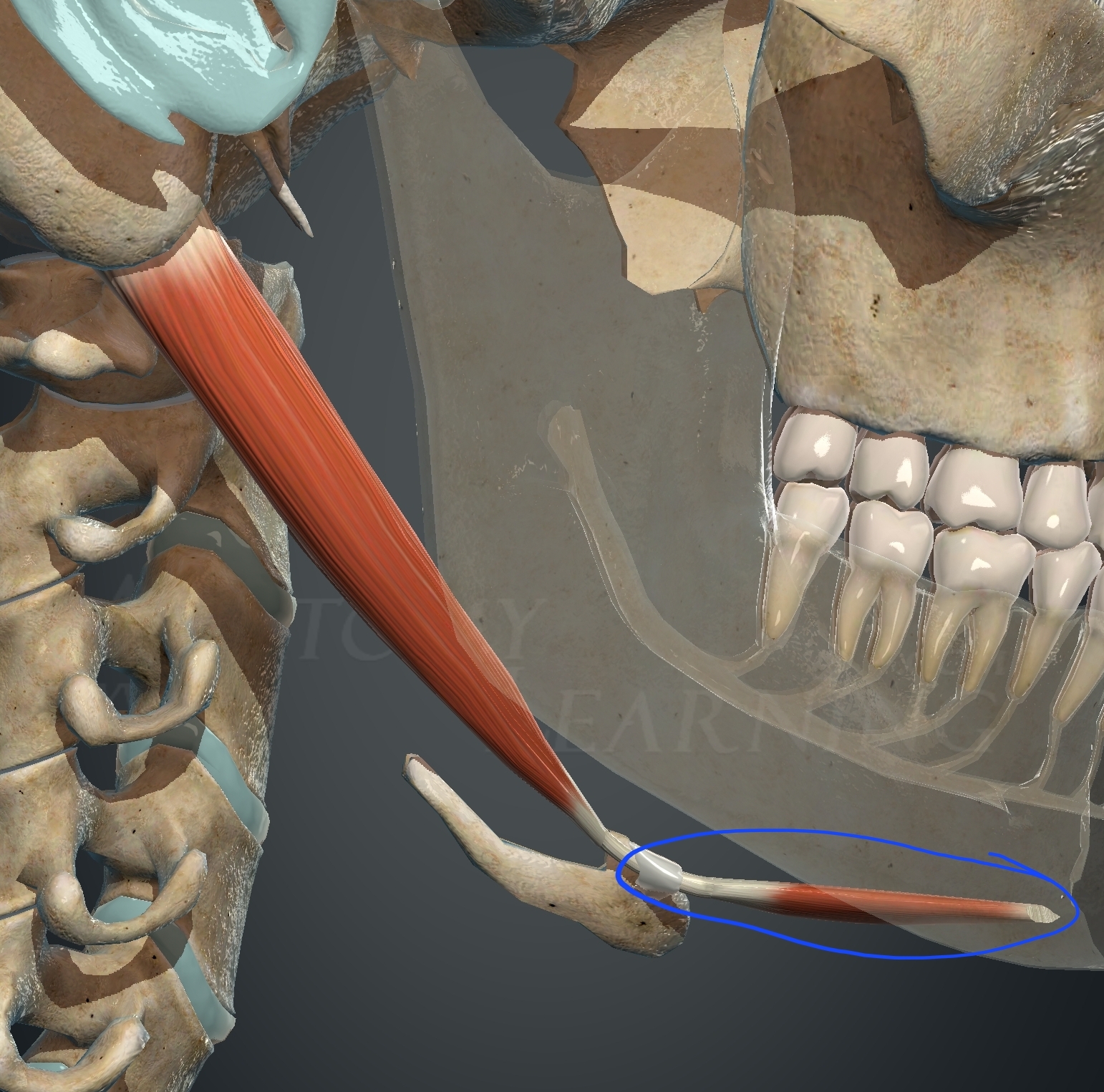
What muscle is this?
Anterior Belly of the Digastric muscle
Origin: Digastric fossa of the mandible
Insertion: Intermediate tendon
Innervation: Mylohyoid nerve (branch of mandibular nerve V3)
Action: Elevates the hyoid, depresses the mandible
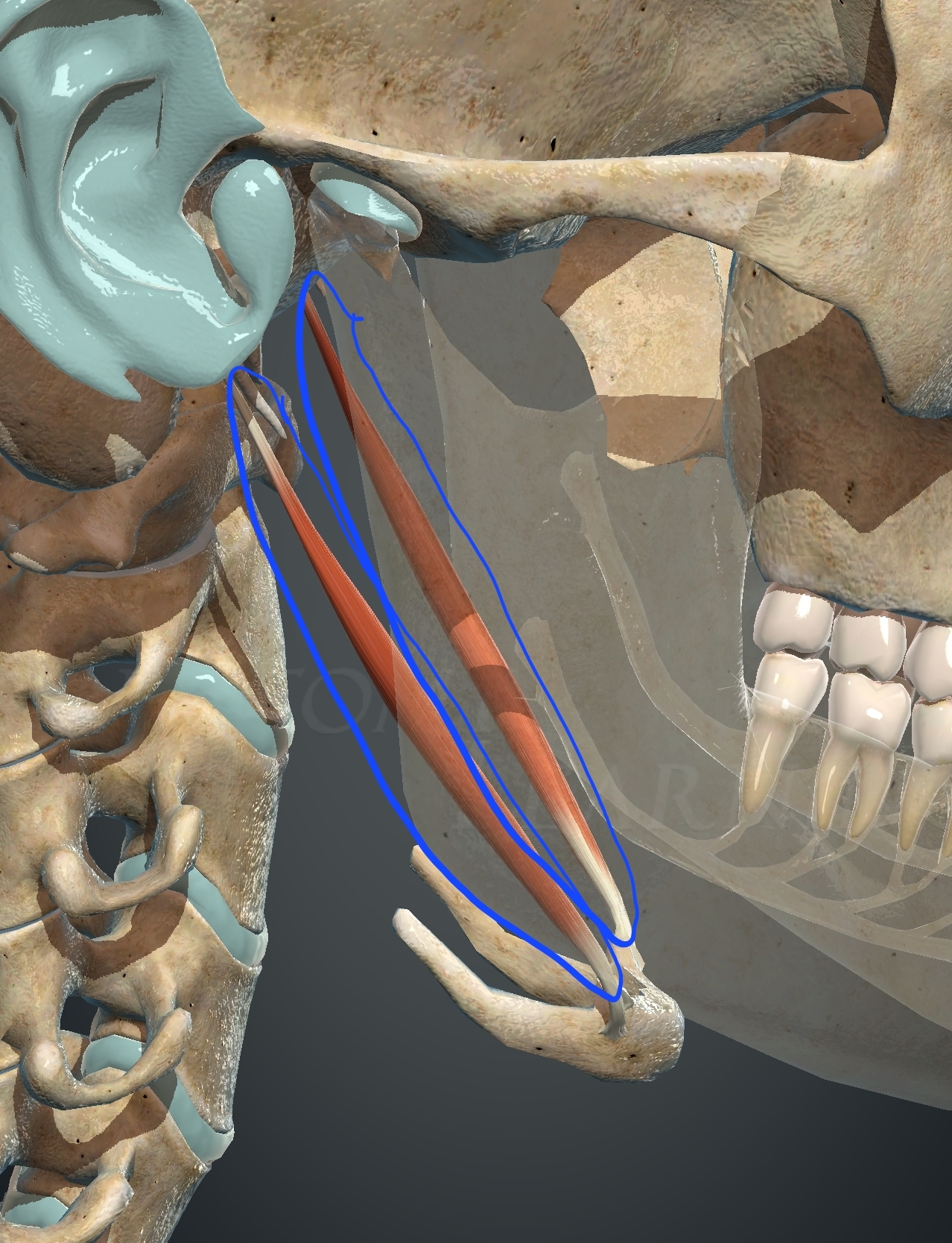
What muscle is this?
Stylohyoid muscle
Origin: Styloid process of the temporal bone
Insertion: Hyoid
Innervation: Facial nerve (VII)
Action: Elevates the hyoid in a posterosuperior direction
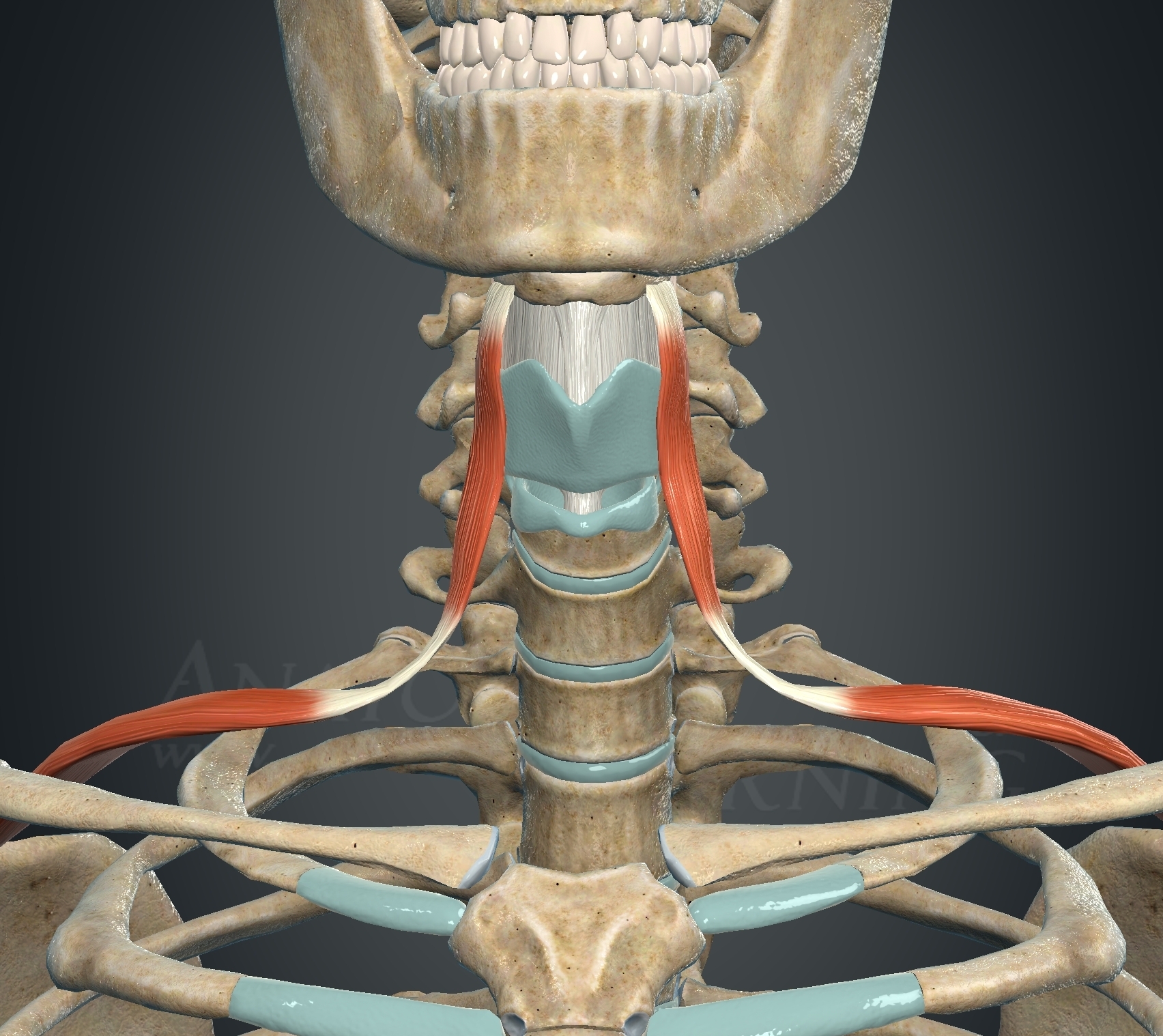
What muscle is this?
Omohyoid muscle
Origin: Superior border of the scapula
Insertion: Hyoid
Innervation: Ansa cervicalis (branch of hypoglossal nerve XII and of C1, C2, and C3)
Action: Descends the hyoid and larynx during swallowing and phonation
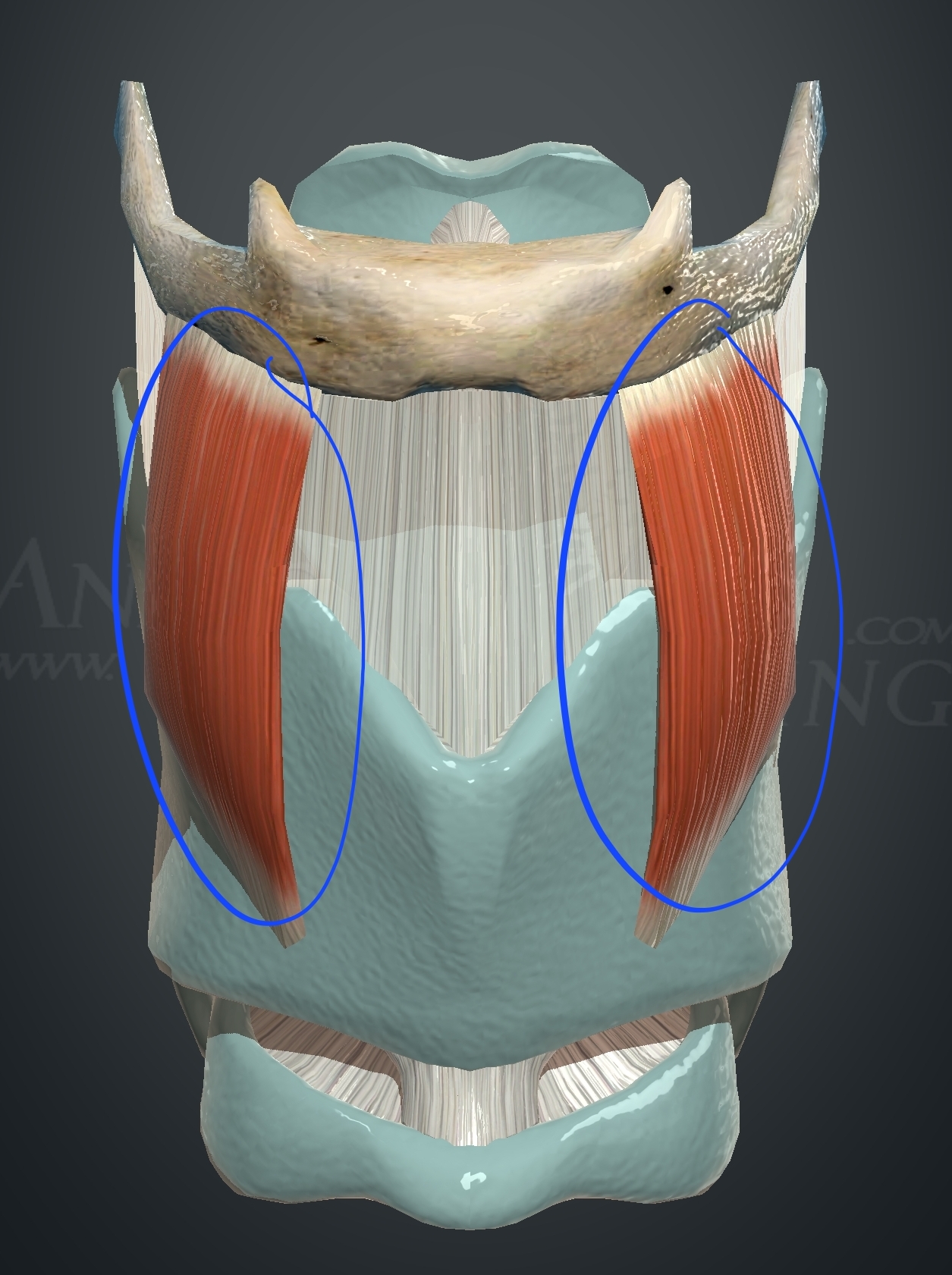
What muscle is this?
Thyrohyoid muscle
Origin: Oblique line of the thyroid cartilage
Insertion: Hyoid
Innervation: Hypoglossal nerve (XII)
Action: Depresses the hyoid and larynx during swallowing and phonation
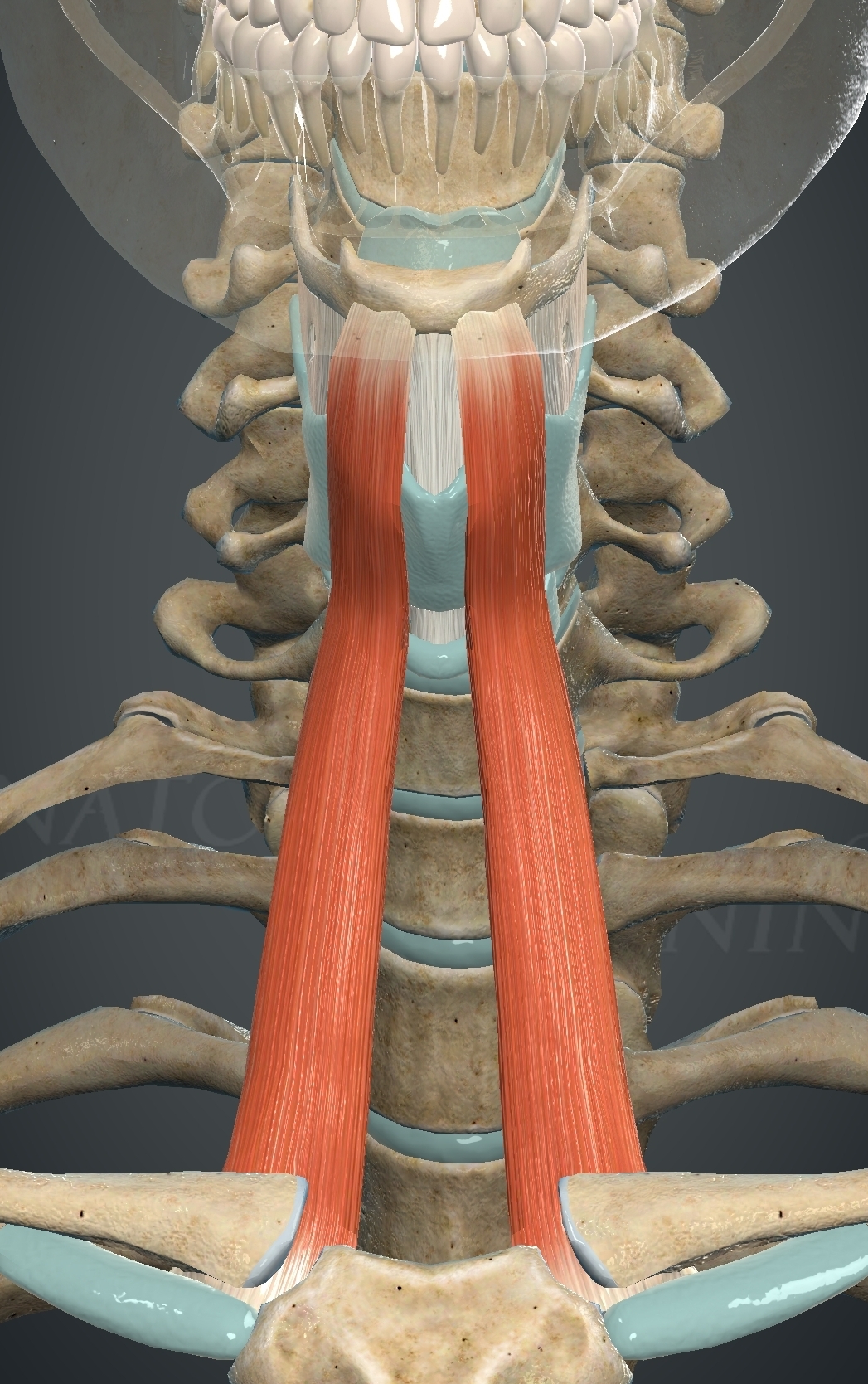
What muscle is this?
Sternohyoid muscle
Origin: Posterior aspect of the sternum, adjacent areas on the clavicle and posterior sternoclavicular ligament
Insertion: Hyoid
Innervation: Ansa cervicalis (branch of hypoglossal nerve XII and of C1, C2, and C3)
Action: Depresses the hyoid and larynx during swallowing and pronation
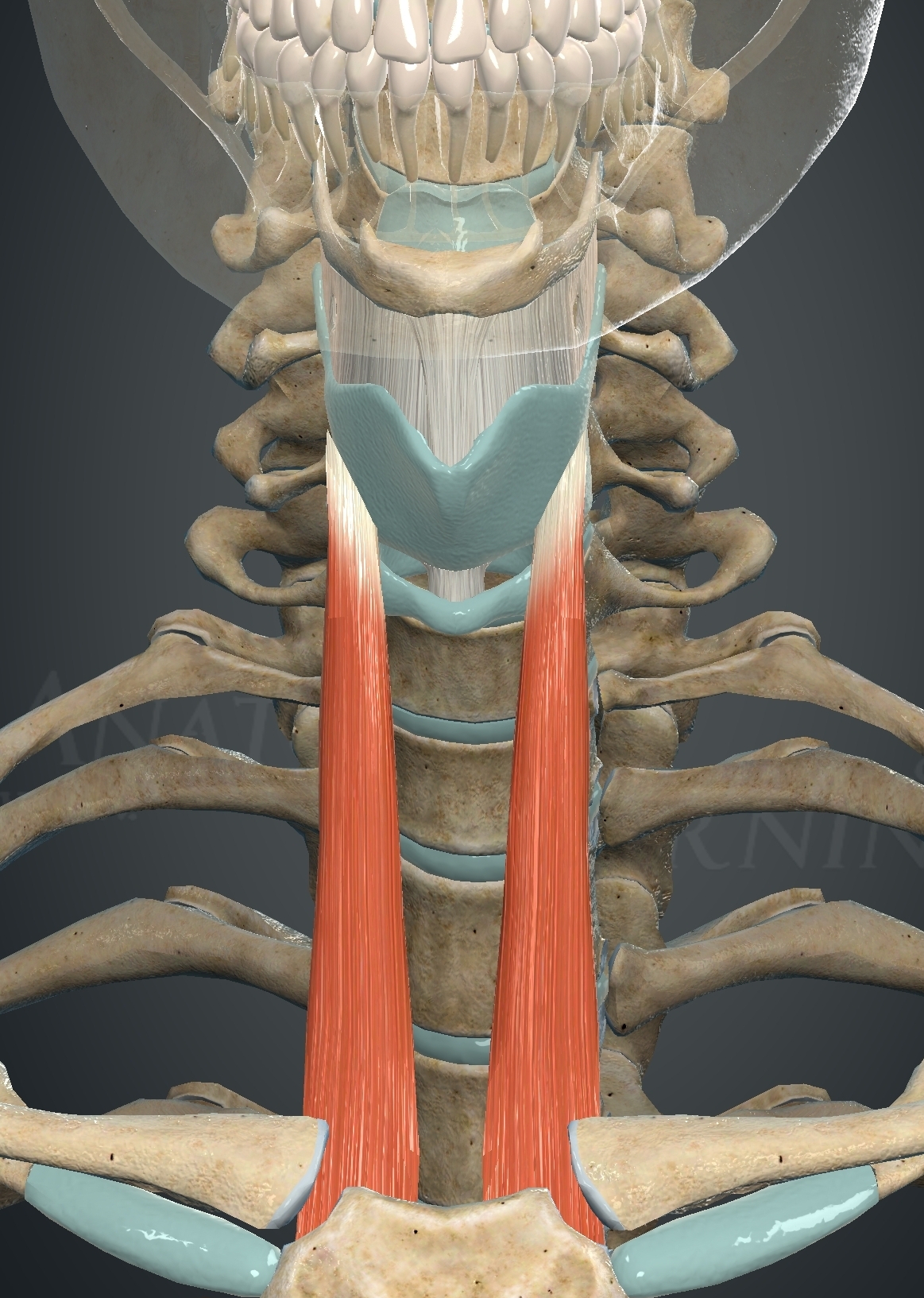
What muscle is this?
Sternothyroid muscle
Origin: Posterior aspect of the sternal manubrium and adjacent area of the first costal cartilage
Insertion: Oblique line of the thyroid cartilage
Innervation: Ansa cervicalis (branch of hypoglossal nerve XII and of C1, C2, and C3)
Action: Depresses the hyoid and larynx during swallowing and phonation
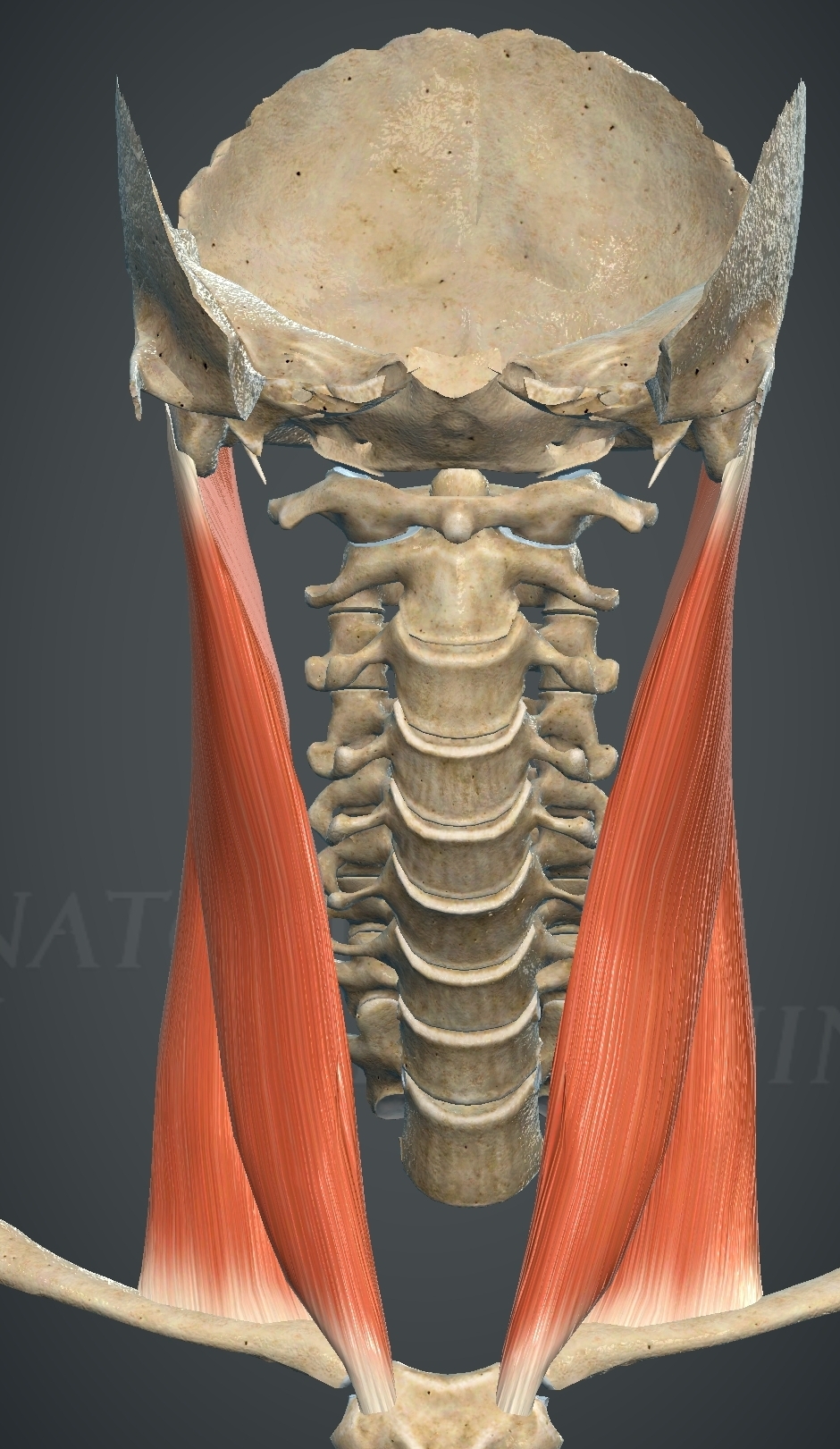
What muscle is this?
Sternocleidomastoid
Origin: Long tendon on the anterior aspect of the sternum, short tendon on the superior border of the sternal third of the clavicle
Insertion: Mastoid and superior nuchal line
Innervation: Accessory nerve (XI)
Action:
Bilateral Contraction: extension of atlantooccipital joint and first cervical vertebrae, flexion of the last cervical vertebrae, elevation of the clavicle and sternum during inspiration
Unilateral Contraction: flexion, lateral flexion, and contralateral rotation of the head
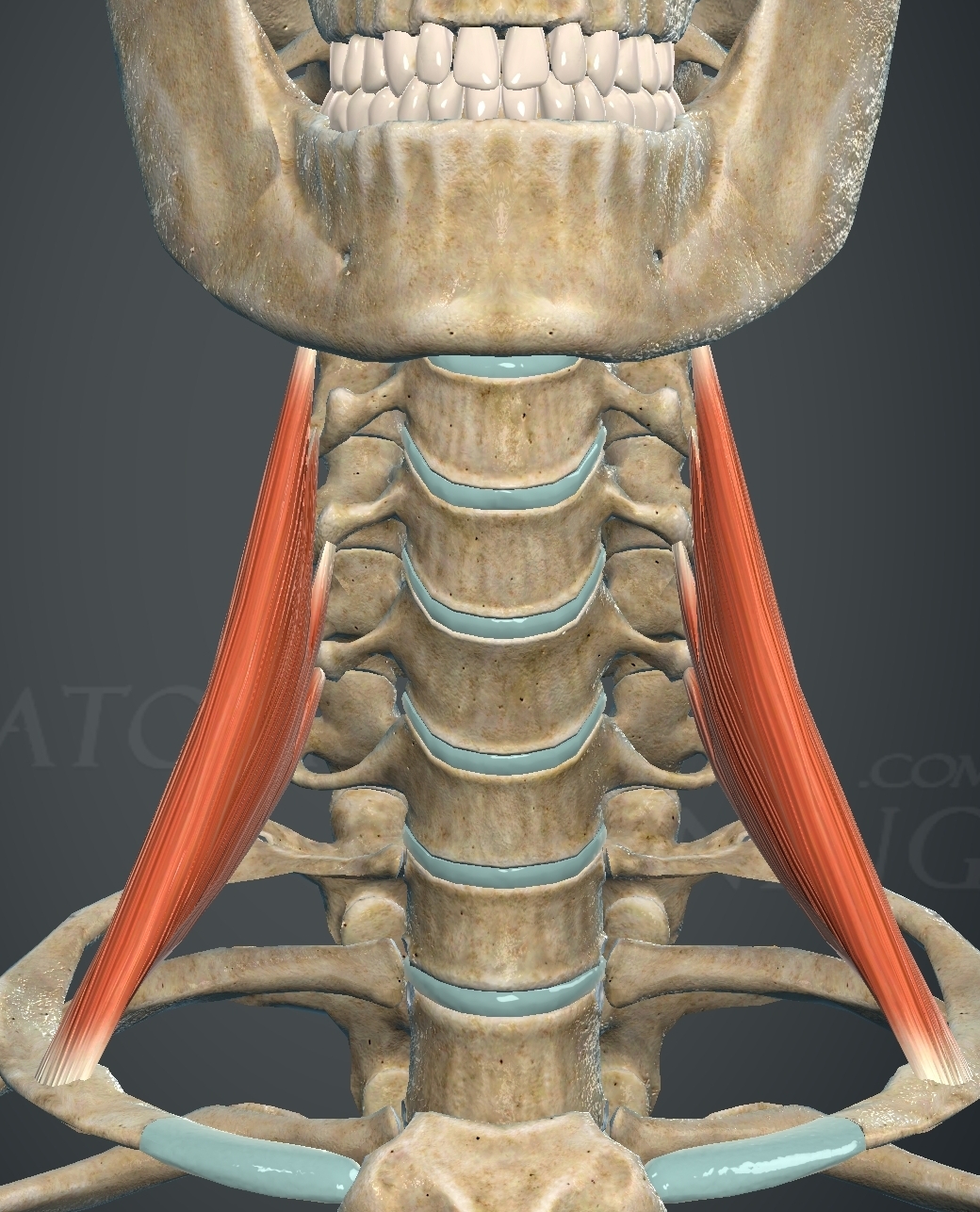
What muscle is this?
Scalenus Anterior
Origin: Anterior tubercles of the transverse processes of the third to sixth cervical vertebrae
Insertion: 1st rib (tubercle of the anterior scalene muscle)
Innervation: Direct branches from the cervical and brachial plexuses
Action:
Bilateral Contraction: neck flexion, elevates the first rib during inspiration
Unilateral Contraction: flexion and contralateral rotation of the cervical spine
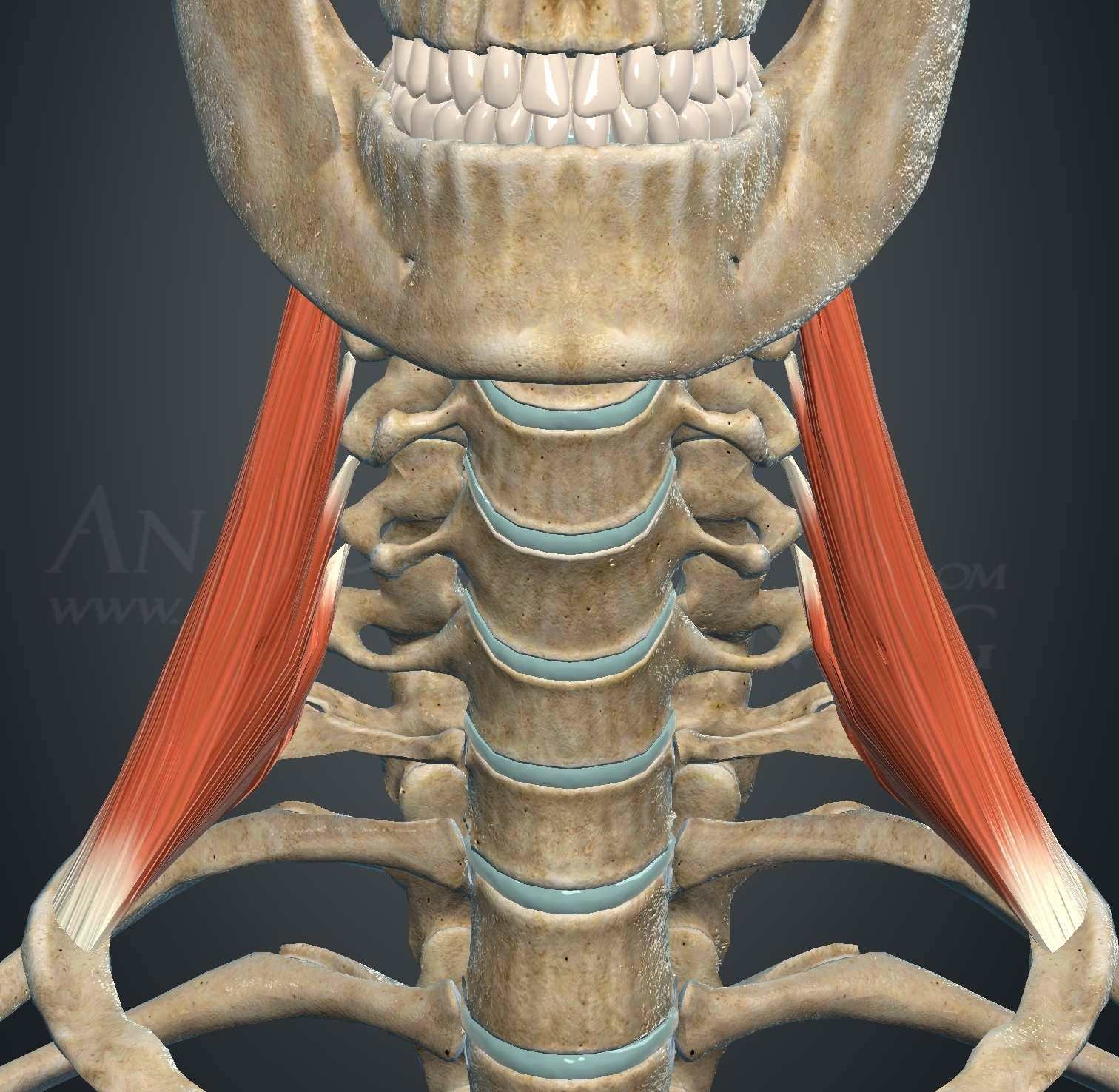
What muscle is this?
Scalenus Medius
Origin: Anterior tubercles of the transverse processes of the cervical vertebrae
Insertion: 1st rib (posterior to the groove of the subclavian artery)
Innervation: Direct branches from the cervical and brachial plexuses
Action:
Bilateral Contraction: neck flexion, elevates the first rib during inspiration
Unilateral Contraction: flexion and contralateral rotation of the cervical spine
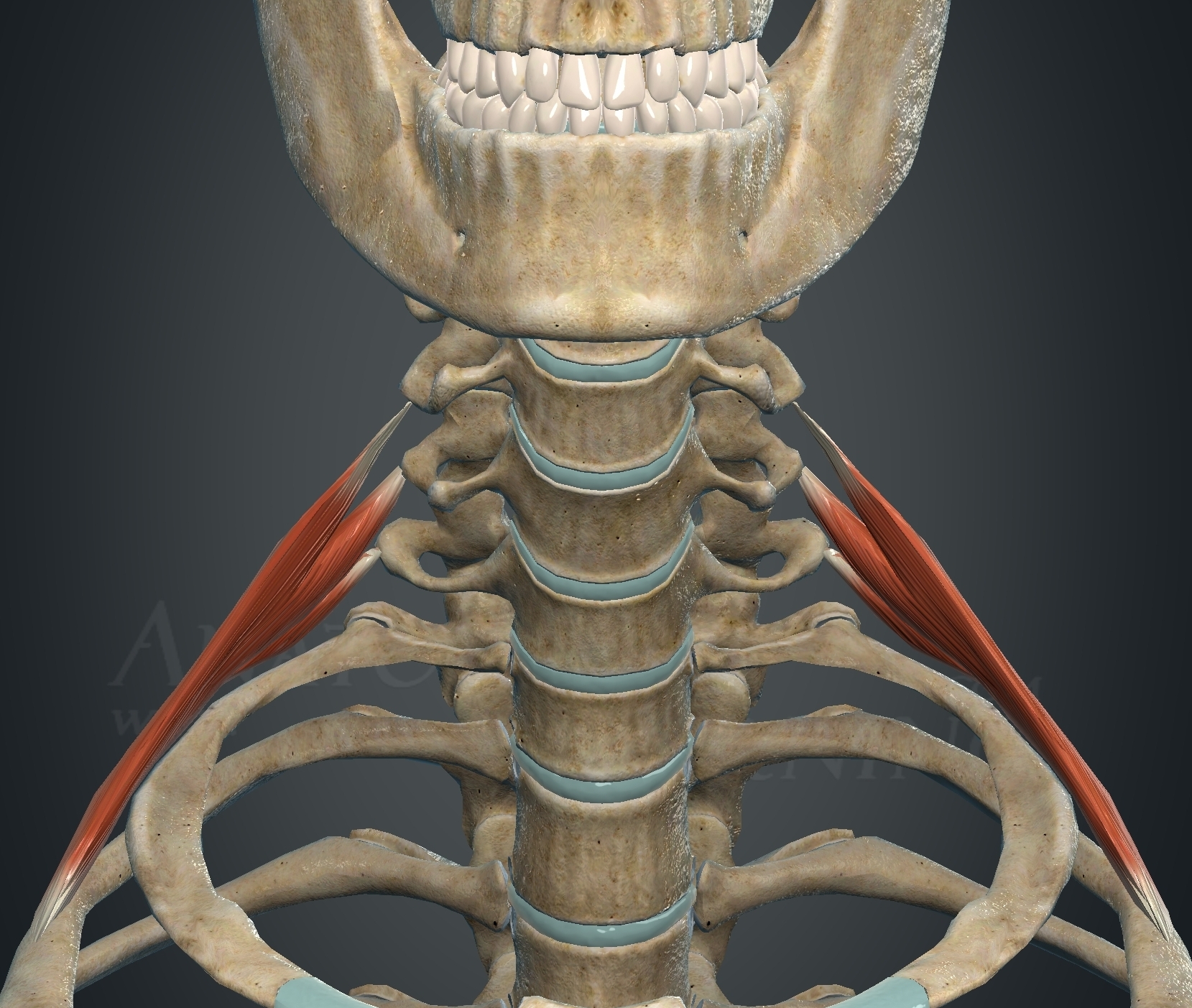
What muscle is this?
Scalenus Posterior
Origin: Posterior tubercles of the transverse processes of the fifth and sixth cervical vertebrae
Insertion: 2nd rib
Innervation: Direct branches from the cervical and brachial plexus
Action:
Bilateral Contraction: neck flexion, elevates the first two ribs during inspiration
Unilateral Contraction: flexion and contralateral rotation of the cervical spine
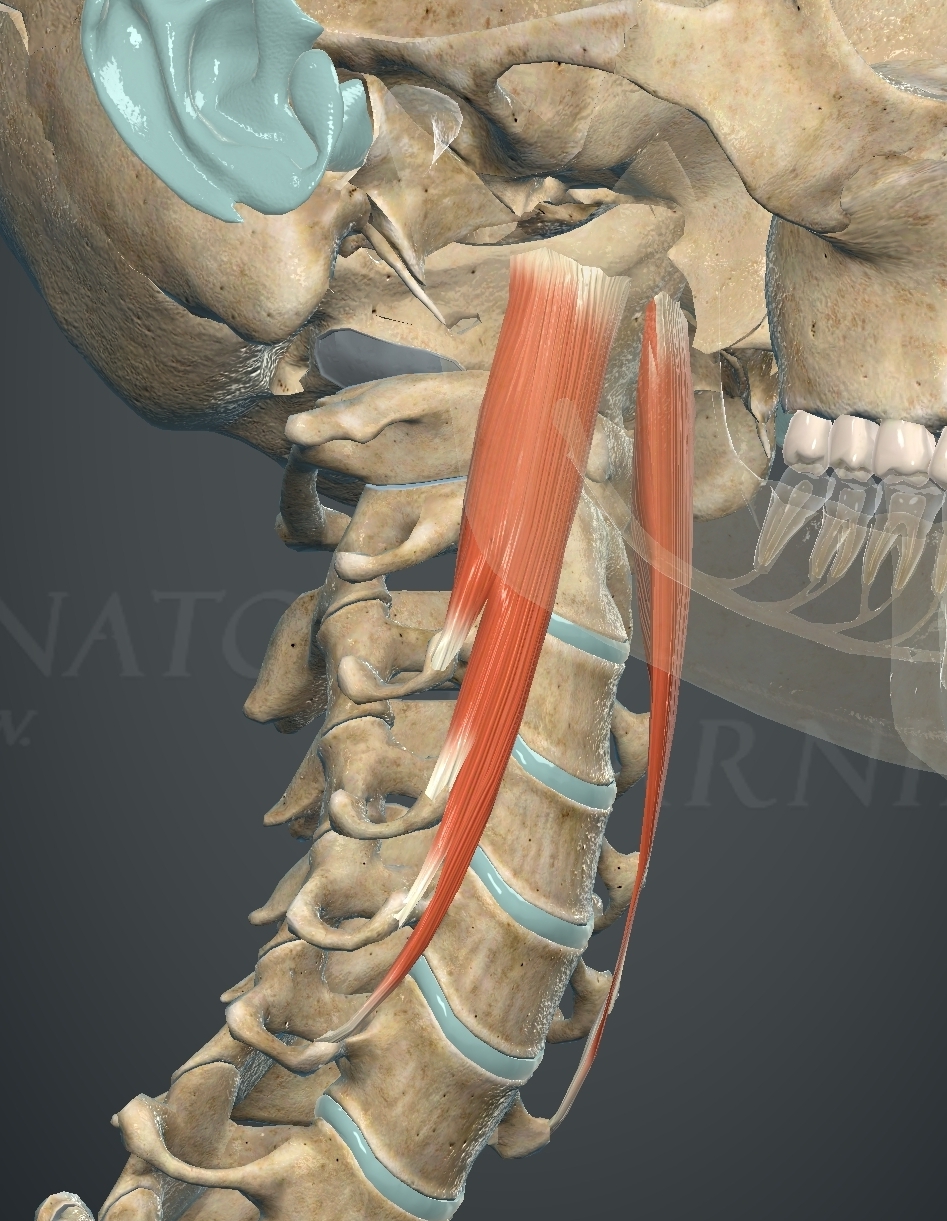
What muscle is this?
Longus Capitis
Origin: Anterior tubercles of the third to sixth cervical vertebrae
Insertion: Basilar portion of the occipital bone
Innervation: Direct branches from the cervical plexus
Action:
Bilateral Contraction: flexion of the neck and head
Unilateral Contraction: contralateral rotation of the neck and head
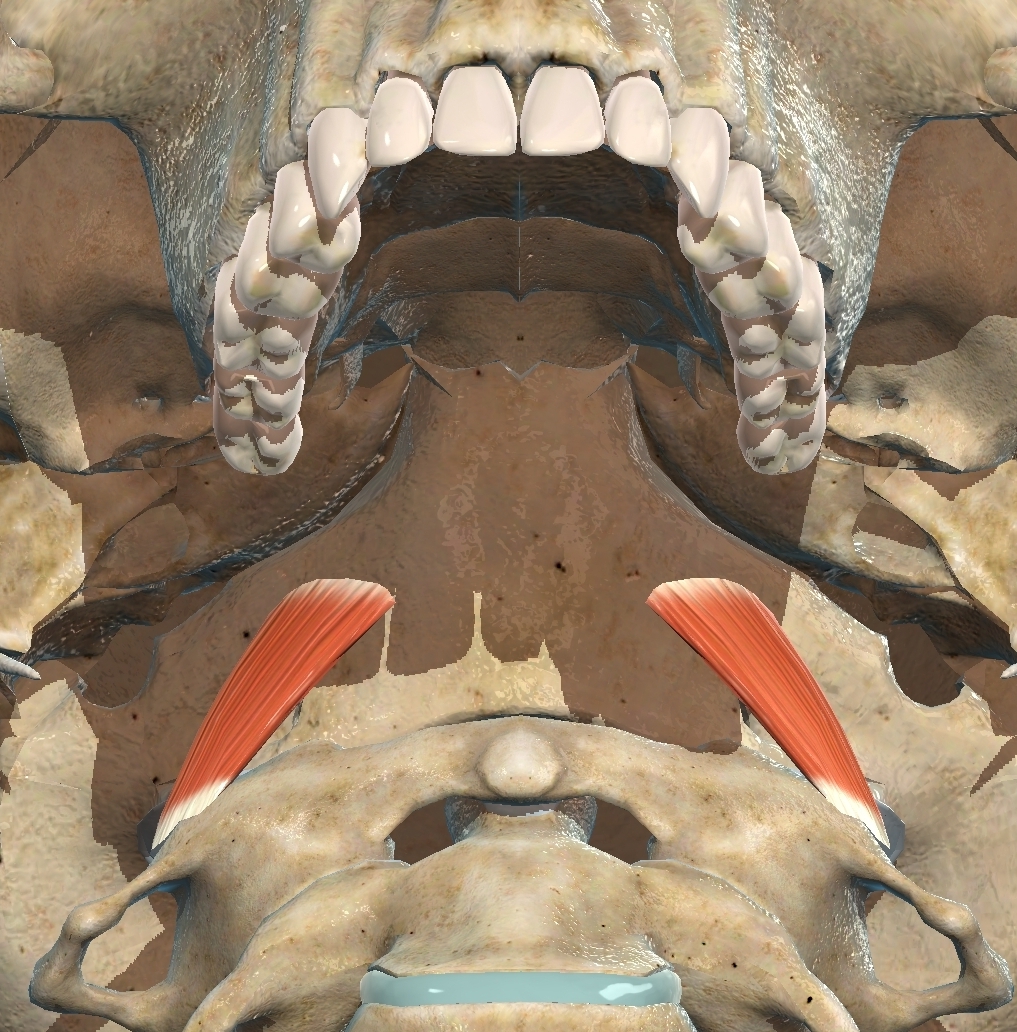
What muscle is this?
Rectus Capitis Anterior
Origin: Transverse process of the atlas
Insertion: Basilar portion of the occipital bone
Innervation: Ventral branches from the cervical plexus
Action: Flexion of the occipitoatlantoid joint
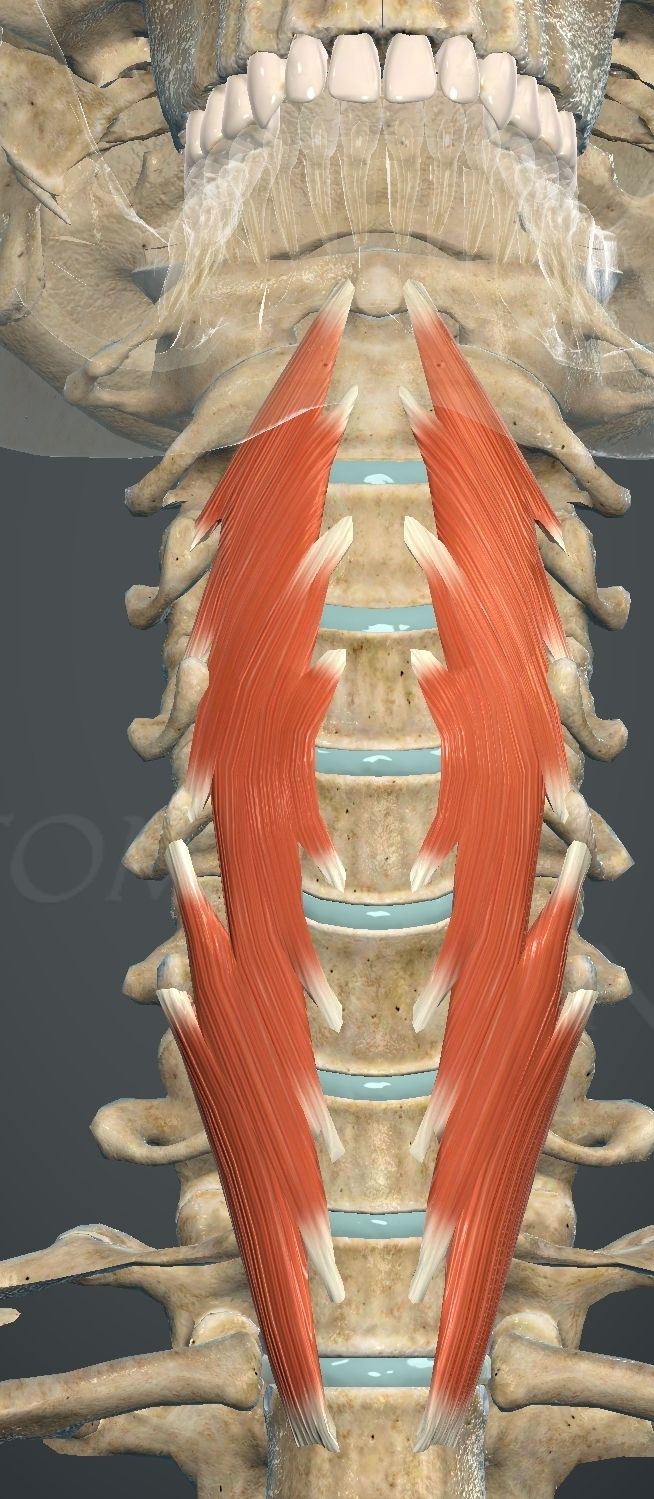
What muscle is this?
Longus Colli
Origin: Tendon of the bodies of the last cervical and first thoracic vertebrae, anterior tubercles of the first cervical vertebrae, lateral surface of the bodies of the first thoracic vertebrae
Insertion: Bodies of the first thoracic vertebrae, anterior tubercles of the atlas, and body of the first cervical vertebrae, lateral surface of the bodies of the first thoracic vertebrae
Innervation:
Action:
Bilateral Contraction: neck and head flexion
Unilateral Contraction: lateral flexion of the head, lateral creaneal portion ipsilaterally rotates the neck, caudal lateral portion rotates the neck contralaterally
What muscle is this?
Origin:
Insertion:
Innervation:
Action:
What muscle is this?
Origin:
Insertion:
Innervation:
Action:
What muscle is this?
Origin:
Insertion:
Innervation:
Action:
What muscle is this?
Origin:
Insertion:
Innervation:
Action:
What muscle is this?
Origin:
Insertion:
Innervation:
Action:
What muscle is this?
Origin:
Insertion:
Innervation:
Action:
What muscle is this?
Origin:
Insertion:
Innervation:
Action:
What muscle is this?
Origin:
Insertion:
Innervation:
Action:
What muscle is this?
Origin:
Insertion:
Innervation:
Action:
What muscle is this?
Origin:
Insertion:
Innervation:
Action:
What muscle is this?
Origin:
Insertion:
Innervation:
Action:
What muscle is this?
Origin:
Insertion:
Innervation:
Action:
What muscle is this?
Origin:
Insertion:
Innervation:
Action:
What muscle is this?
Origin:
Insertion:
Innervation:
Action:
What muscle is this?
Origin:
Insertion:
Innervation:
Action:
What muscle is this?
Origin:
Insertion:
Innervation:
Action:
What muscle is this?
Origin:
Insertion:
Innervation:
Action:
What muscle is this?
Origin:
Insertion:
Innervation:
Action:
What muscle is this?
Origin:
Insertion:
Innervation:
Action: